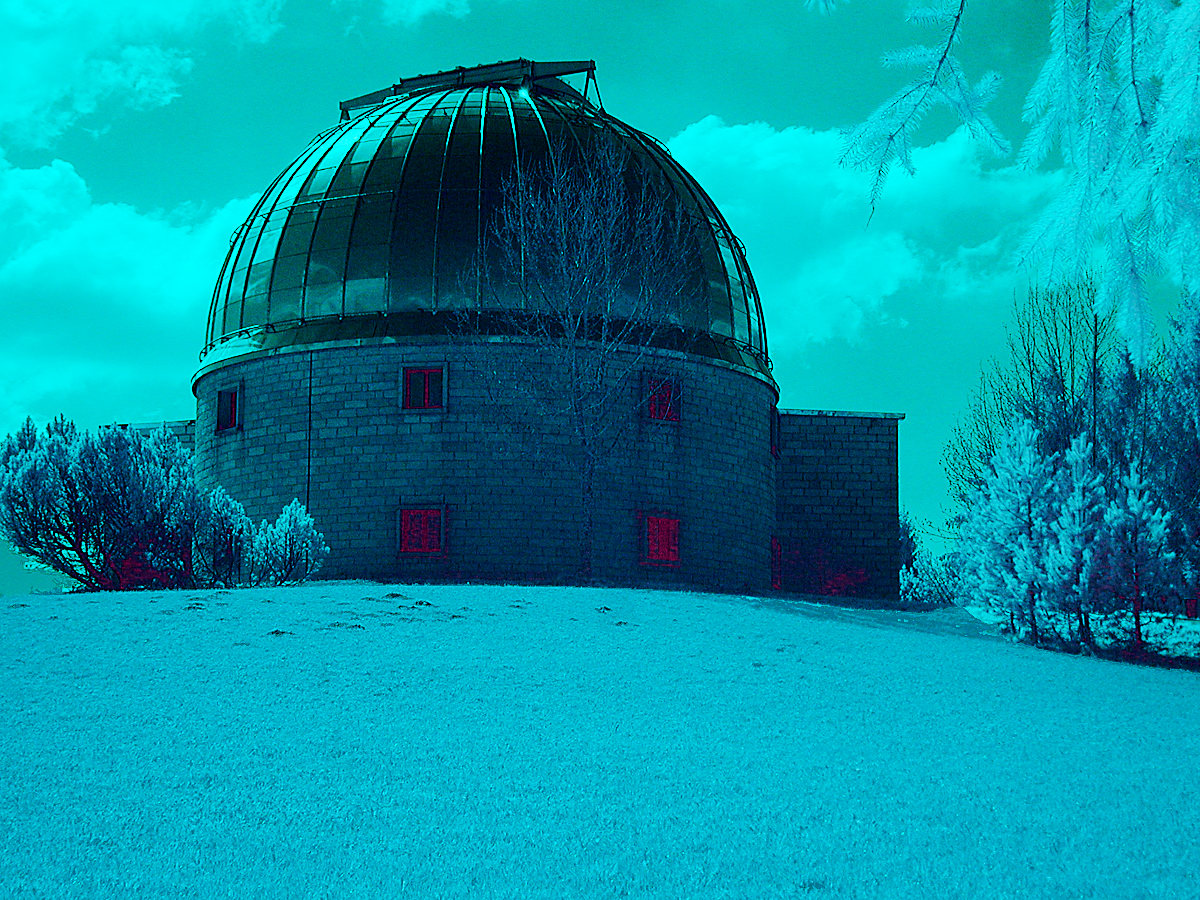L'inizio dell''astronomia
infrarossa si data al periodo di Sir William Herschel, che misurò la
temperatura di tutti i colori dello spettro elettromagnetico
osservando che questa aumentava andando dal colore rosso al violetto.
Herschel pose un termometro appena oltre il rosso e ancora con grande
stupore misurò una temperatura dove non vedeva radiazione, concludendo
che i raggi calorici che provengono dal Sole dovevano essere invisibili
all'occhio e trovarsi appena al di la del rosso dello spettro visibile.
Con questo celebre esperimento vennero scoperti i raggi infrarossi.Un
grande ulteriore passo avvenne nel 1878 quando il fisico americano
Samuel Pierpoint Langley inventò un'apparecchiatura chiamata bolometro,
esso era costituito da una striscia di platino delle dimensioni di 1cm x
1 mm x 0,01 mm e colorato di nero, il filo di platino presenta una
resistenza elettrica che è funzione della temperatura. Langley pose il
bolometro sulla fenditura del suo spettroscopio e studiò lo spettro
infrarosso del Sole.Nel 1973 un pallone sonda con un bolometro al
germanio venne utilizzato per effettuare osservazioni infrarosse di
Marte. Nei primi anni '70 venne scoperto che anche le galassie emettono
nell'infrarosso mentre nel 1974 il Kuiper Airborne Observatory iniziò a
volare e compiere osservazioni.Questo era un osservatorio infrarosso
montato su un aereo della NASA e che è rimasto in funzione per oltre 20
anni. Negli anni '80 nascono i primi sensori allo stato solido sensibili
nell'infrarosso, simili ai CCD ottici. Ciò permise nel 1983, ad opera di
una collaborazione tra USA, Regno Unito e Olanda, di lanciare in orbita
il primo telescopio infrarosso: IRAS, che permise di scoprire 500.000
nuove sorgenti infrarosse, un disco di polvere attorno a Vega, emissioni
da galassie interagenti e nubi di polveri galattiche.Da allora numerosi
telescopi infrarossi, operanti fuori dell'atmosfera terrestre, quali
ISO,
Spitzer, la camera NICMOS dell'HST. Altri telescopi e rivelatori IR sono stati collocati in
Antartide,avvalendosi delle basse temperature e della scarsa umidità di
alcune zone del continente.Tra le sperimentazioni effettuate vi è anche
la ricerca dei pianeti extrasolari.Tra le surveys del cielo infrarosso
più conosciute ed estese c'è quella del 2 Mass (Two
Micron ALL Sky Surveys), che ha scansionato dal 1997 il 70% del cielo e
scoperto oltre 5700 sorgenti IR usando due telescopi dedicati alla
ricerca IR da 1,3 mt, sul monte Hopkins (Arizona) ed uno al CTIO (Cile).Nelle figure seguenti (fonte INAF, 2
MASS) sono riportate la posizione dell'IR nello spettro
elettromagnetico,e le bande di indagine e la magnitudine limite della survey 2MASS.Dall'epoca
dell'inizio di tale survey, molti progressi sono stati
fatti , ed è recente la notizia, del 17 luglio 2010, del completamento
della prima survey di WISE (NASA Wide field infrared
explorer).Il telescopio spaziale infrarosso della NASA ha una
sensibilità centinaia di volte superiore al suo predecessore del 1983 ,
IRAS.Il campo applicativo di WISE è la ricerca dei
NEO (asteroidi e comete vicino all'orbita terrestre), e, più avanti ed
in profondità,delle nane brune, dischi protoplanetari e sorgenti
galattiche ultraluminose nell'IR.
The beginning of infrared astronomy is due to Sir William
Herschel who first measured the colors of solar spectrum, observing that
its temperature increased from red to violet.Herschel put the termometer
beyond the red, observing that there was a temperature where no
radiation was visible, understanding that some rays coming from the sun,
beyond the red were invisible to the eye.A further step in this field
happened in 1878, when the american scientist Samuel Langley built a
device called bolometer, made of a platinum wire coloured in black.The
wire had an electrical resistance that is function of temperature.Langley
put the bolometer on its spectroscope and studied the infrared spectrum
of the sun.In 1973 an atmospheric balloon with a germanium bolometer was
used for infrared observations of Mars.In 1974 the Kuiper Airborne
Observatory, an infrared telescope mounted on a NASA airplane, begun to
fly and made observations.In 1983, a collaboration between United States,
Holland and United Kingdom allowed to launch in orbit IRAS, the first
infrared satellite, that discovered more than 500000 infrared
sources.From then, many infrared telescopes were launched and operated
out the terrestrial atmosphere, as ISO, Spitzer, and HST Nicmos camera.Some
other telescopes and IR detectors were set in Antarctica, using the low
temperatures and the humidity absence of some places of that continent.Among
the most popular infrared surveys of the sky there is the 2 MASS
(Two Micron All Sky Surveys), which since 1997 has scanned 70% of the
sky and found more than 5700 IR source using two telescopes devoted to
IR
research one of
1,3
m on Mount Hopkins (Arizona) and one at CTIO (Chile). The following
figures (source INAF, 2 MASS) shows the position of infrared in the
electromagnetic spectrum, and bands of research and the limiting
magnitude of the Survey
2MASS.From the beginning of this survey, much progress
has been made, and the recent news of July 17 2010,is the
completion of the first survey of WISE (NASA Wide Field Infrared
Explorer). The NASA infrared space telescope
has a sensitivity a hundred times higher than its predecessor of 1983,
IRAS.The field of application of WISE is the search for NEOs (near
Earth's orbit asteroids and comets), and, further and deeper, brown
dwarfs, protoplanetary disks and
galactic sources ultraluminous in the IR.

Classificazione Astronomica dell'IR
| |
| vicino |
0,7 - 1 µm -
428-300 THz |
5 µm - 60 THz |
| medio |
5 µm - 60 THz |
25-40 µm -
12-7,5 THz |
| lontano |
25-40 µm -
12-7,5 THz |
250-350 µm -
1,2 THz-428 GHz |
2MASS Survey
-
| |
Magnitude Limits |
| Band |
Wavelength (µm) |
Point Sources (SNR=10) |
Extended Sources |
| J |
1.25 |
15.8 |
15.0 |
| H |
1.65 |
15.1 |
14.3 |
| Ks
|
2.17 |
14.3 |
13.5 |
Riporterò ora, qui di
seguito, le mie esperienze di amatore nel campo dell'astronomia IR,
con particolare attenzione per le Galassie e gli oggetti nebulari.Caratteristica
particolare dell'IR in astronomia è data dalla capacità di penetrare
le nubi di polvere e di gas, per evidenziare i nuclei di galassie,
le zone di formazione stellare e quant'altro.Le camere CCD che ho
usato, e che uso per tale attività, sono la Atik 16
HR e la Sbig ST8 XME, quest'ultima si è
dimostrata notevolmente più sensibile dell'altra in tale regione
spettrale, e quindi è quella da me più usata nell'ultimo periodo.E'
bene precisare che la capacità del proprio setup a raccogliere l'IR
dipende da vari fattori, quali la sensibilità della camera ,
l'esistenza o meno del vetrino IR-cut sul sensore,lo strato
antiriflesso ed in generale il tipo di coating delle ottiche.Inutile
quindi tentare riprese IR con una DSLR non opportunamente modificata
per tale uso, vale a dire senza alcun vetrino blocca IR sul sensore.E'
bene precisare che l'indagine amatoriale in tale campo può
unicamente sfruttare la finestra NIR tra 700 e 1000 nm (nella
migliore delle ipotesi), dato che oltre tale limite la capacità del
sensore delle camere CCD per uso amatoriale e l'assorbimento
atmosferico, per non parlare della temperatura a livello del suolo
od a bassa altitudine, rendono impossibile ogni indagine. Entro
tale finestra, comunque, i sensori ed i filtri disponibili possono
dare notevoli soddisfazioni all'astronomo amatore che si addentra in
tale appassionante settore di ricerca astronomica.Tra i filtri da
utilizzare ho sperimentato con successo Il Baader Planetarium IR
pass > 685 nm e l'Astronomik Ir pass > 742 nm, con una leggera
preferenza per quest'ultimo, più selettivo.Ho anche sperimentato,
per curiosità, un filtro in gelatina Kodak 87C > 800 nm, che
tuttavia , dato il notevolissimo assorbimento, richiede sensori
molto sensibili nell'IR ed ottiche di grande diametro.Riguardo a
quest'ultimo punto, riterrei che già con diametri dell'obiettivo di
200 mm si possono ottenere risultati interessanti con filtri
selettivi.Per obiettivi più piccoli e teleobbiettivi sono
preferibili i passa IR a banda più larga come il Baader 685.Ma in
definitiva, qual'è il vantaggio dell'uso di filtri NIR selettivi per
l'amatore? la risposta è, a mio avviso,semplice: la possibilità di
bypassare l'inquinamento luminoso, che alle maggiori lunghezze
d'onda non
disturba le riprese CCD,e di usufruire di un seeing medio più
vantaggioso.
I'll take
back now, here below, my experiences of amateur in the IR astronomy, with
particular attention to the galaxies and nebular objects .A particular
feature of the IR is the ability to penetrate the clouds of dust and gas
, to highlight the nuclei of galaxies, regions of star formation and so on. The
CCD cameras I've used, and that I use for this activity are the Atik 16 HR and
SBIG ST8 XME, that has proved remarkably
more sensitive than others in this spectral region, and the one I used most in
the last period.It's useful to specify that the capabilities of your setup to
collect the IR depends on various factors such as the sensitivity of the camera,
the
existence or otherwise of the IR-cut glass over the sensor, the reflective layer
and in general the type of coating of the optics .It's then useless IR shooting
with a DSLR not suitably modified for this use, ie with no IR cut filter
on the sensor
. It's clear that the good amateur observation in this field can only take
advantage of the NIR window between 700 and 1000 nm (at best), because above
that limit the ability of the sensor of CCD cameras for amateur and the
atmospheric absorption
, not to mention the temperature at ground level or low altitude, make
impossible any research. Within that window, however, sensors and filters
available by amateur astronomer can give the great satisfaction to go into this
exciting field of
astronomical
research. About
the filters to use, I have experienced success with the Baader Planetarium IR
pass> 685 nm and the Ir Astronomik pass> 742 nm, with a slight preference for
the latter, more selective.I've also experienced a, a
Kodak gelatin
filter
87C> 800 nm,that, however, given the very substantial absorption, requires very
sensitive CCD sensors and high diameter optics.About last point, I would think
that even with diameters of 200 mm lens can be obtained
interesting results with selective filters .For smaller telescope objective and
telephoto lenses are preferable broader band pass IR filters as the Baader
685.But ultimately, what is the advantage of using NIR-selective filters for the
amateur?
the answer , in my opinion, is simple: the ability to bypass the light
pollution, which at high wavelenghts does not disturb the CCD imaging, and enjoy
a more favorable medium seeing .
Osservazioni di Galassie in luce NIR (742 - 950 nm)
Galaxies observations in near IR light (742 -950 nm)
Il Gruppo Maffei
The Maffei Group
Le galassie del
Gruppo Maffei , esclusa IC 342, sono
situate sul
piano della nostra galassia e sono state tutte scoperte in tempi
recenti, a causa dell'oscuramento procurato dalle stelle e dai gas e polveri
interstellari interposti tra noi e la sorgente.Esse sono in numero di dieci,come
di seguito elencate, in ordine di magnitudine (nel blu),Tengo a precisare che
per le galassie situate sul piano galattico, ossia tutte quelle in elenco
esclusa, come si è detto, la prima, le magnitudini risultano spesso controverse,
probabilmente a causa dell'estinzione, della rilevazione IR, ed altri fattori,
quelle qui riportate mi sembrano quelle effettive, anche sulla base della
esperienza da me effettuata :
The Maffei
group galaxies - except IC 342 - are situated in the galaxy plane and their
discovery has been done in last years, due to dust and stars interposed among us
and the source.They are in number of ten, as hereunder shown, in (blue)
magnitude order.It's useful to underline that for these galaxies a precise mag
measurement it's difficult to do, may be for the light estinction, IR search,
and so on, and it is easy to find different mag classifications.
0 - IC
342
9.2
1- Maffe1
-
14.4
2- Maffei
2 -
16.0
3 - Perseus 1
16.2
4 - Perseus 2
16.8
5 - Dwingeloo1
18.8
6 - MB 1
19,5
7 - MB 2
?
8 - MB 3
19.8
9 - Dwingeloo 2
20.5
Le due galassie
principali del gruppo, Maffei 1 e 2 (esclusa, come si è detto, IC 342), estese rispettivamente 18.2 e 21.4 ',
sono state scoperte nel 1968 dall'astronomo italiano Paolo Maffei, con l'uso di
lastre all'infrarosso, che poterono penetrare il pulviscolo ed il gas
interstellare interposto. Esse si trovano ad una distanza di circa 10 e 16 milioni di anni
luce e sono morfologicamente una ellittica ed una spirale barrata.l due oggetti erano stati precedentemente classificati come nebulose
ad emissione nel catalogo Sharpless delle regioni HII del 1959.Seguono
immediatamente dopo, come estensione angolare, Dwingeloo 1 e 2, rispettivamente
di 8.0 e 5.4 ', scoperte ancora più recentemente, nel 1994 e nel 1995.
The two main
galaxies of the group, Maffei 1 and 2, have, respectively an extension of
18.2 and 21,4' , and have been discovered in 1968 by italian astronomer Paolo
Maffei, using infrared film, capable to see beyond the interstellar dust of
galactic plane.They are placed at a distance of about 10 and 16 millions light
years and are, from the morphological point of vue, an elliptical and a barred
spiral galaxy.The two objects were previously classified as emission nebulas in
the Sharpless catalogue of HII regions, in 1959.Follow, as angle extension,
Dwingeloo 1 and 2, respectively of 8.0 and 5.4 ', recently discovered in 1994
and 1995.
L'osservazione
di tali oggetti costituisce già una bella sfida da località che godono di cieli
cristallini, figurarsi poi da quelli di una città come Roma.Comunque, ho
raccolto ugualmente tale sfida, nella convinzione che il mio ultimo acquisto, un
Celestron 14 XLT,potesse essere vantaggiosamente utilizzato per una survey della
zona del piano galattico nelle vicinanze di Cassiopea nell'IR vicino , tra 742 e
950 nm circa, allo scopo di superare l'emissione del pulviscolo e dei gas
interstellari.Il filtro scelto è stato un Astronomik Ir pass 742 nm. La finestra
utile per le riprese era quindi da tale valore ai 950 nm circa,quasi al limite della
sensibilità spettrale del sensore Sony ICX 285 che equipaggia la mia camera Atik
16 HR,che risulta in quel punto di circa il l2-13% (vedere il grafico che
segue), a mio avviso il massimo per poter ancora
distinguere il segnale in arrivo sul rumore, termico e non, di fondo cielo.Nessun
problema dalle ottiche, nè dal trattamento XLT che lascia passare l'IR,
perlomeno sino a tale limite.
Observation of
such objects is a true challenge from dark sky sites, imagine to try it from
urban skies of a city like Rome!Anyway, i gave a try, hoping that my recent buy,
A Celestron 14 XLT could be used for a galactic plane survey near
Cassiopea in near IR light.I choosed an Astronomik IR pass 742 nm filter, to
bypass the interstellar dust and make the Maffei group galaxies visible.The
useful window for CCD imaging was the one among 742 ad 950 nm, being this last
value near the upper spectral response limit of the Sony ICX 285 sensor used by
my Atik 16 HR CCD camera, with a sensitivity of about 12-13% (see the graphic
below),in my opinion the
very limit to separate the incoming light from the termic environmental
noise.No problem from neither the scope optics nor XLT coating.
Non ho ritenuto
di usare filtri IR più selettivi, come il Kodak 87 C in gelatina, che pure
posseggo, per il semplice motivo che le galassie in questione non sono vere e
proprie sorgenti IR, e quindi l'uso del filtro ha, in questo caso , la sola
finalità di bypassare l'oscuramento indotto dal pulviscolo e dai gas
interstellari.Il segnale compreso in tale banda non viene infatti, a mio avviso
a ragione, considerato come segnale termico propriamente detto.L'uso di un
filtro più forte, da località cittadine, avrebbe avuto il solo effetto di
oscurare anche la già debole luce delle galassie da osservare.
I didn't decide
to use more selective filters, as Kodak 87 C IR gelatine filter, that I own, for
the simple reason thet the galaxies I tried to imagine weren't true IR
source,and IR filtering was done to bypass the interstellar
dust of galactic plane . Consequently the use of a stronger filter could cut the
incoming light of galaxies too.
La montatura
equatoriale utilizzata è stata una Losmandy G11, e questo ha posto una serie di
problemi, costringendomi in pratica all'uso della tecnica della somma delle
immagini singole, dato che la focale usata (2600 mm circa) non consentiva un uso
proficuo dell'autoguida.Tuttavia, pur con questo ed altri accorgimenti, la
montatura ha comunque svolto il suo compito.
I used a
Losmandy G11 equatorial mount ,that I first believed unfit to make CCD imaging with
an ota of similar weight and focal lenght.Anyway, the mount, with some useful
improvements and with the single frames sum technique, was equally able to do the
job.
Relativamente
alla camera CCD, ho utilizzato una Atik 16 HR con sensore Sony ICX 285 AL, che
presenta, come si vede dal grafico sottostante (fonte Sony) una
risposta spettrale nell'IR tra 750 e 1000 nm che va dal 55 al 6% circa;
valori di tutto rispetto,che permettono di sfruttare la capacità delle ottiche.Non
ho dati sulla banda passante della finestra ottica di chiusura della camera,
quindi faccio riferimento ai soli dati del sensore, pur tenendo conto che questi
vanno probabilmente ridotti in funzione dei valori di trasmissione di questa.
The CCD camera used was a n Atik 16 HR with a Sony ICX 285 sensor, whose spectral
response from 750 to 1000 nm, how you can see from the graphic (courtesy Sony) range from
55 to
6 %, with a good use of optical capability.I've no data about the optic window
of the camera, so I refer exclusively to the sensor values, taking in account
that probably these are to be reduced.
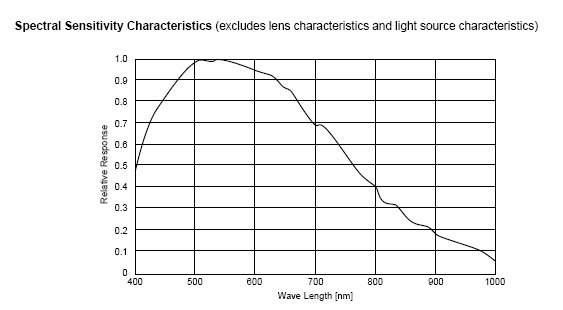
Sono stato
spronato ad effettuare il tentativo in questione in quanto riprese digitali delle
galassie di Maffei in alta risoluzione ( tra i 2 e 3 metri di focale) non mi sembrano essere state effettuate
in campo amatoriale.Nell'ambito professionale, sono state effettuate riprese
dalla survey 2 MASS , ma nella zona spettrale di 2 micron.Sicuramente si è
trattato del primo tentativo dalla zona centrale di una metropoli.
I
had the idea to try such kind of galaxy imaging due to the fact that amateur
observations of Maffei group from a big city seems never be done until now: it
is an interesting approach to test the capability of CCD high resolution near
infrared imaging from high polluted areas.
Relativamente
alla tecnica usata, ho effettuato, come detto, riprese singole di 20 sec,
sommando con Astroart 3 da un minimo di 134 ad un massimo di 274 frames,per integrazioni quindi
dell'ordine di 45 - 90 min, ad una focale effettiva di 2600 mm circa (forse
superiore) dato che il C 14 è stato accoppiato ad un riduttore di focale f 6.3
Meade, Devo dire che la resa dello strumento in accoppiata col riduttore ed il
filtro Astronomik è stata eccellente: stelle puntiformi sino ai bordi, le uniche
imperfezioni sono state dovute all'errore periodico ed agli "strappi " della
montatura , visibilmente sotto stress, per quanto ancora perfomante sino ai 30
sec, e talvolta, a seconda delle zone di cielo, addirittura sino ai 60 secondi
di posa non guidata.Mi sono tuttavia voluto mantenere sui 20 secondi per
sfruttare tutti i frames (l'utilizzo ha sfiorato infatti il 99%).Inutile dire
che le condizioni ambientali sono state le solite, con molte luci del palazzo di
fronte accese, e quindi pessime.Delle quattro galassie del gruppo che ho ripreso
, nella seconda metà di settembre 2007, sino ai primi giorni di ottobre, Maffei
1 è stata l 'unica chiaramente visibile anche con una posa di soli 20 secs,
mentre Maffei2 era visibile a stento, Dwingeloo 1 visibile solo con la somma dei
frames e Dwingeloo 2 NON visibile nemmeno dopo la somma di 234 frames per
ben 90 minuti di integrazione.Sul caso riferirò poi in seguito.
The technique
used was, as I said before, single 20 secs shots stacked by Astroart 3 and
ranging from a minimum of 134 to a maximum of 274 frames, at an effective focal
lenght of 2600 mm , with the C14 coupled to a Meade F 6.3 focal reducer.The
coupling gave excellent results, with pinpoint stars all across the field: some
elongated stars were the consequence of mount periodic error, nonobstandig this, the
overall perfomance of G11 was quite good, considering the weight and the F.L.,
with good unguided frames of 30, and, in some cases, of 60 secs.Anyway, I
preferred to use a 20 secs integration time in order to use all the images being
shot.The environmental conditions were as usual, with a lot of lights from the
front building, and then very bad.Of four galaxies I tried to imagine , only
Maffei 1 was clearly visible in a single 20 secs frame: Maffei 2 was quite
invisible, Dwingeloo 1 visible only after all frames stacking, while Dwingeloo 2
was invisible also after 274 frames
stacking.
Qui di
seguito sono mostrate le immagini e la loro analisi
Here
the images with their analysis

Maffei1 - IR G B
IR 134 frames stacked, green 32, Blue 30 la dominante Ir causa la resa cromatica
spostata verso il rosso. Roma, settembre 2007.
Maffei 1 IR G B
- note the reddish color due to the infrared contribution.Rome, september 2007
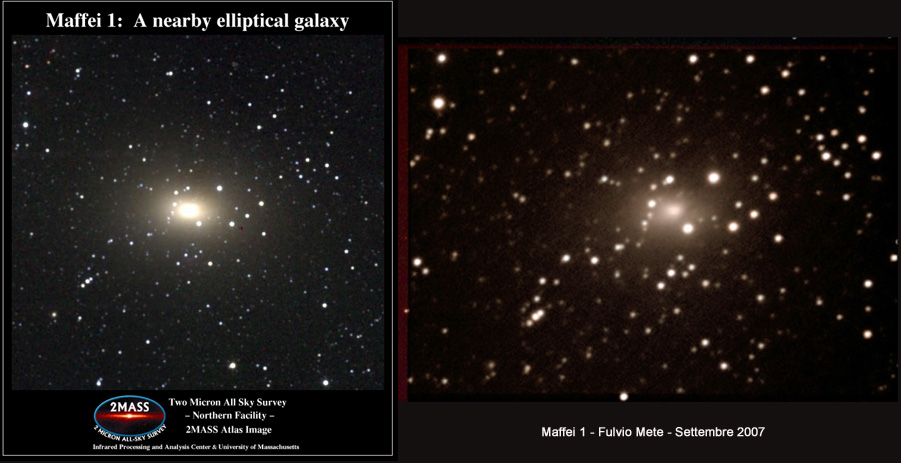
Qui
di sopra è riportato il confronto con l'immagine della galassia ripresa dal
Satellite Infrarosso nell'ambito della survey 2 MASS (2 Micron All Sky
Survey).Notare come la differenza di banda passante (2000 nm in media contro 850
circa in media della mia immagine non si traduca in una altrettanto evidente maggiore
resa dei dettagli dell'oggetto, pur essendo, com'è ovvio , l'immagine del
satellite qualitativamente migliore della ripresa da me effettuata.
Here above is shown
a comparison among my image and the one of 2 Micron All Sky Survey (2 MASS)
satellite.Note as the different IR bandpass (2000 nm versus 850 in medium value)
is not enough to show many more details of the object, remaining, in every case,
the 2 MASS image obviously far better than mine.
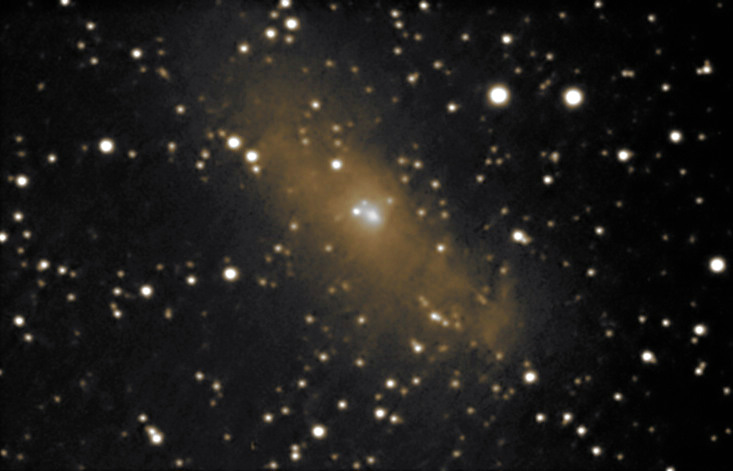
Maffei 2 -
IR - 184 frames da 20 sec stacked, falsi colori , dato che la intrinseca
debolezza del segnale ha consigliato l'uso del solo IR.Roma, settembre 2007
Maffei2 - IR - 184 frames
20 secs each stacked -IR only- false colors.Rome, september 2007
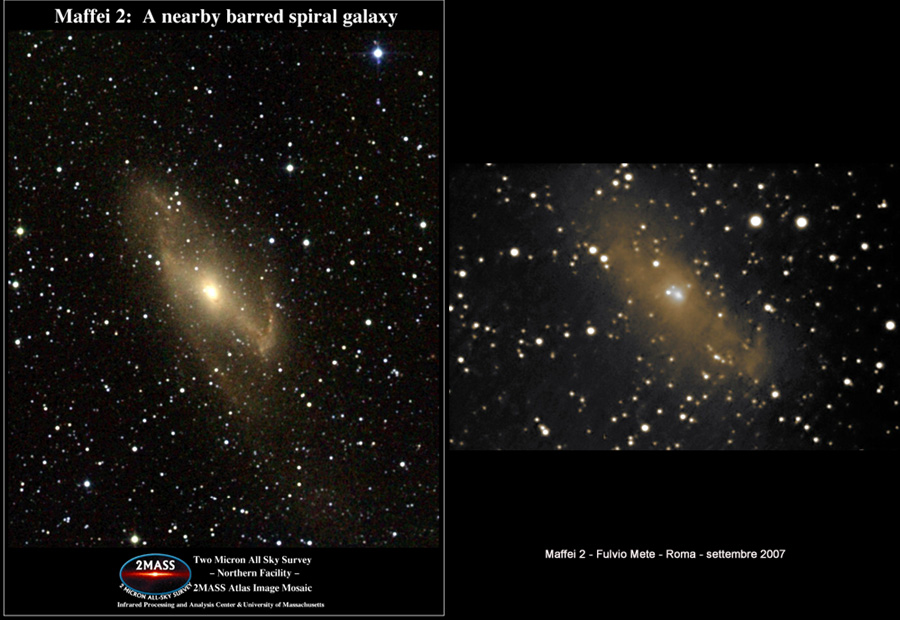
Qui
di sopra è riportato, anche per Maffei 2 , il confronto con l'immagine della
galassia ripresa dal 2 MASS .
Above , for
Maffei 2 galaxy too, the comparison with 2 Mass IR survey image

Dwingeloo 1 - somma
di 175 immagini da 20 secs- Roma, settembre 2007
Dwingeloo 1 - 175 20secs frames
stacked- Rome, september 2007
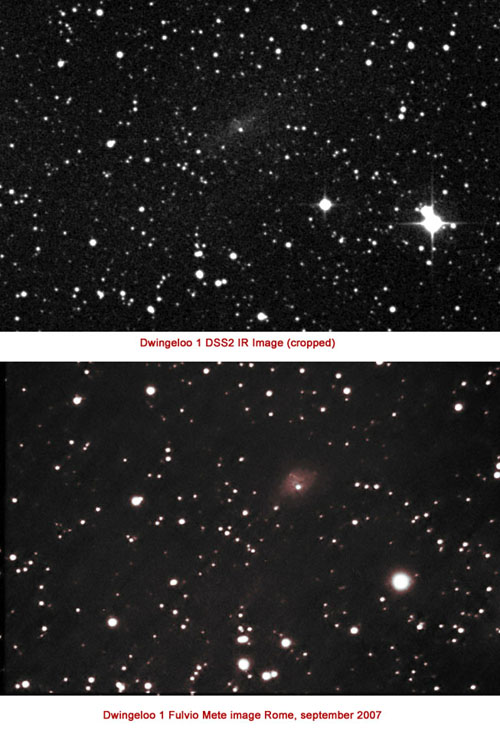
-
Di sopra ho
riportato il confronto con la Survey DSS2 in luce IR , dato che Dwingeloo
1 non risulta nel database 2 MASS, probabilmente in quanto eccedente la
sensibilità degli strumenti della survey.
Above
is the comparison of Dwingeloo 1 with DSS2 IR image, for the galaxy doesn't
appears in the 2MASS images database, perhaps because its magnitude exceed the
limit of the survey.
L'ultima delle
galassie importanti del gruppo è stata oggetto,ai primi di ottobre, di un tentativo di ripresa
effettuato più per forma che nella speranza di ottenere un risultato ,
improbabile in un oggetto
nebulare di mag integrata 20.5 dal centro di Roma. Quindi non mi sono
meravigliato quando nelle singole immagini da 20 secs centrate sulle effemeridi
dell'oggetto non c'era traccia della galassia, e non mi sono ancora meravigliato
quando nella somma di ben 274 frames pari a circa 1 ora e 30 min di integrazione non si
scorgeva nulla.La logica faceva pensare che la galassia emettesse al di sotto
della luminosità del fondo cielo, e quindi era tempo perso cercarla dalla città.Mi
sono, invece, meravigliato, quando da ricerche sul web mi sono accorto che non
c'erano immagini in cui l'oggetto fosse visibile, compresa la survey DSS2 IR.Qui
di seguito è l'immagine da me ripresa ,con contrassegnata la zona dove dovrebbe
trovarsi la galassia ed immediatamente dopo quella del DSS2, più
profonda della mia.L'unica spiegazione
che ho trovato è che la galassia stia quasi sovrapposta alla stella al centro
del campo e quindi la sua debole luminosità sovrastata da questa.Mi sembra
inoltre che, dopo la sua scoperta nel 1995 nel dominio radio alla riga da 21 cm
dell'HI, nessuna osservazione in ottico sia stata effettuata.
The last of
important galaxies of the group, Dwingeloo 2, was imaged just for fun,
knowing that there were very few chances to make the dim galaxy visible beyond
the galaxy plane dust and the polluted sky fog of Rome.So, I wasn't surprised
when in the single 20 secs frame were no sign of the presence of the object, I
wasn't one more time surprised when i didn't find trace of it in a
274 stacked 20 secs images (about 1 hour and 30 minutes of integration).Anyway,
I wonder why there's no trace of galaxy in the DSS2 IR image of the sky centered
on its coordinates.A logical consideration may be that the galaxy lies near the
star marked in the image, and its dim emission is completely drowned in star's
stronger light.I have, furthermore, the impression that , after its discovery in
1995 in the 21 cm radio domain of HI, no optical observations were made.

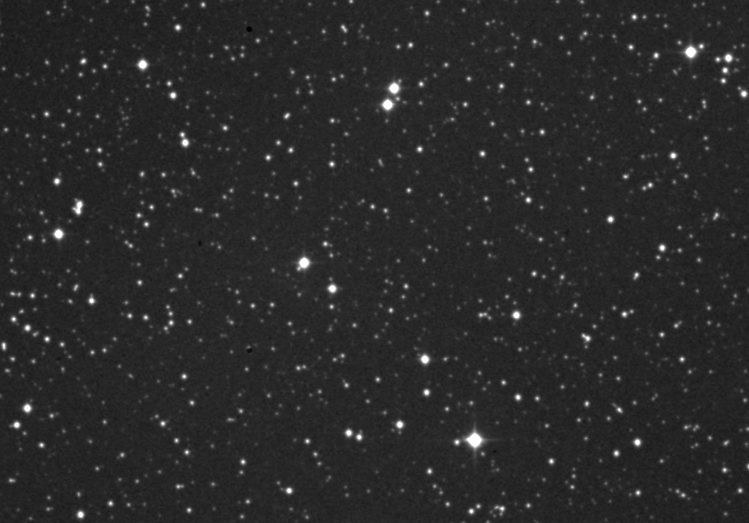
Nell'agosto 2010 ho nuovamente provato la ripresa di Maffei 1
e 2 con un Celestron 8 XLT a f 6,3, da Arcinazzo in Ciociaria,
anzichè da Roma, ed ho ottenuto le seguenti immagini:
In August 2010 I
tried again to shot Maffei 1 and 2 by a Celestron 8 XLT at f
6,3 from Arcinazzo, a small town near Rome, and got the following
images:
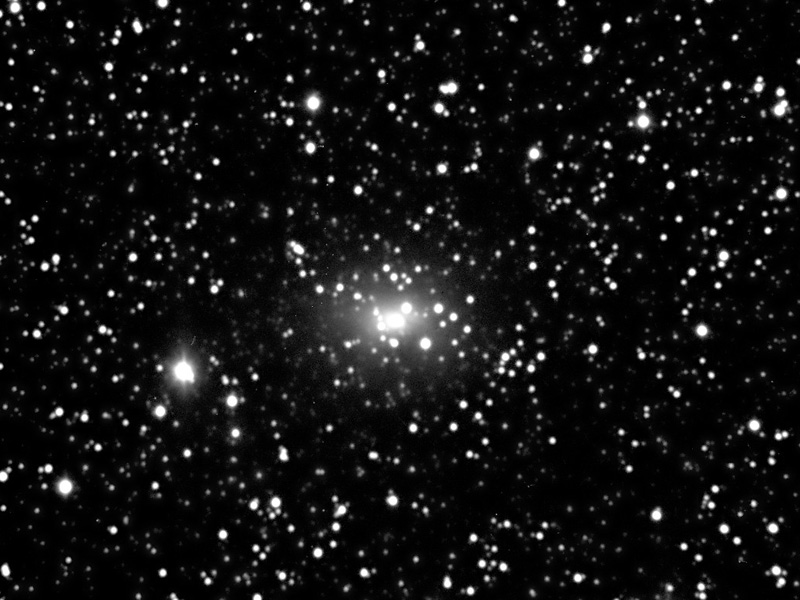

Potrebbe
sembrare che la differenza col C14 da Roma non sia così
evidente come avrebbe dovuto comportare la differenza di diametro,ma un
fattore decisivo è dato dalla camera usata, stavolta una SBIG ST8 XME
con il sensore Kodak KAF 1603, particolarmente sensibile nell'IR, con
una QE di ben il 50% a 800 nm ed ancora del 15% A 950 nm !
It may seem that the
difference with the C14 from Rome isn't so evident as the difference in
diameter, but a decisive factor, in my opinion,is given from the camera
used, now a ST8 XME, with the Kodak KAF 1603 sensor, particularly
sensitive in the infrared, with a QE over the 50% at 800 nm ad 15
% at 950 nm!
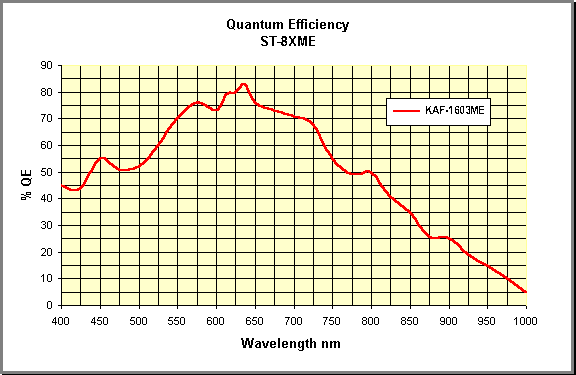
Galassia irregolare
IC 10 in Cassiopea
Irregular Galaxy
IC10 in Cassiopea
L'uso di
tale camera rende relativamente facile la ripresa CCD in IR anche dai
cieli delle grandi città, non solo di Galassie, ma anche di oggetti estesi.L'immagine
sottoindicata è di un soggetto piuttosto difficile da cieli cittadini,
la Galassia irregolare IC 10 in Cassiopea,membro del gruppo locale: essa è stata ottenuta con
un'integrazione di 1h e 40 min al fuoco del mio C14 a f 7 da Roma Ponte
di Nona ed un filtro Astronomik IR pass 742.
The use of the ST8 makes
quite simple the Ir imaging from urban high polluted skies
not only of galaxies, but also of extended objects.The following image
is an object very difficult to image under urban skies as that of Rome,
the irregular Galaxy IC10 in Cassiopea, a member of local group: it was
obtained by an integration of 1 hour and 40 mins at the reduced f 7
focus of my C14 at PNO (Ponte di Nona Observatory) in Rome,and
with an Astronomik IR pass 742 filter.

M1: il famoso residuo di
supernova in Infrarosso e Ha
Un
oggetto nebulare che presenta nel vicino IR un'apparenza completamente
diversa dal visibile è il residuo di supernova del 1054, nella
costellazione del Toro, Messier 1.Le
riprese sono state effettuate in banda IR vicino > 742 nm con
l’uso di un filtro Astronomik IR pass 742, ed in Ha con l’uso di un
Astronomik Ha da 6 nm, usando il mio C14 a f 7 dal mio osservatorio di
Ponte di Nona a Roma.E’ stata quindi effettuata una compositazione delle
due immagini con una elaborazione in falsi colori (falso RGB)
assegnando l’IR al canale R; lo stacking IR-Ha al canale verde e l’Ha al
blu, modificando l’Hue con Psp, in modo da evidenziare sia le
caratteristiche dell’IR che penetra nel cuore di M1 “tagliando” buona
parte di gas e polveri, sia quelle dell’immagine Ha che riprende in
massima parte le strutture filamentari della shell gassosa della
supernova originaria.Si nota come queste ultime siano “rinforzate”
nell’immagine composita, , nella cui parte centrale, cosa strana, si
nota anche leggermente la controparte ottica della struttura centrale a
forma di disco a suo tempo ripresa da Chandra che da origine
all’emissione X della nebulosa. Nell’immagine allegata sono riportate
le tre immagini, la IR, l’Ha e la loro compositazione falsa RGB.
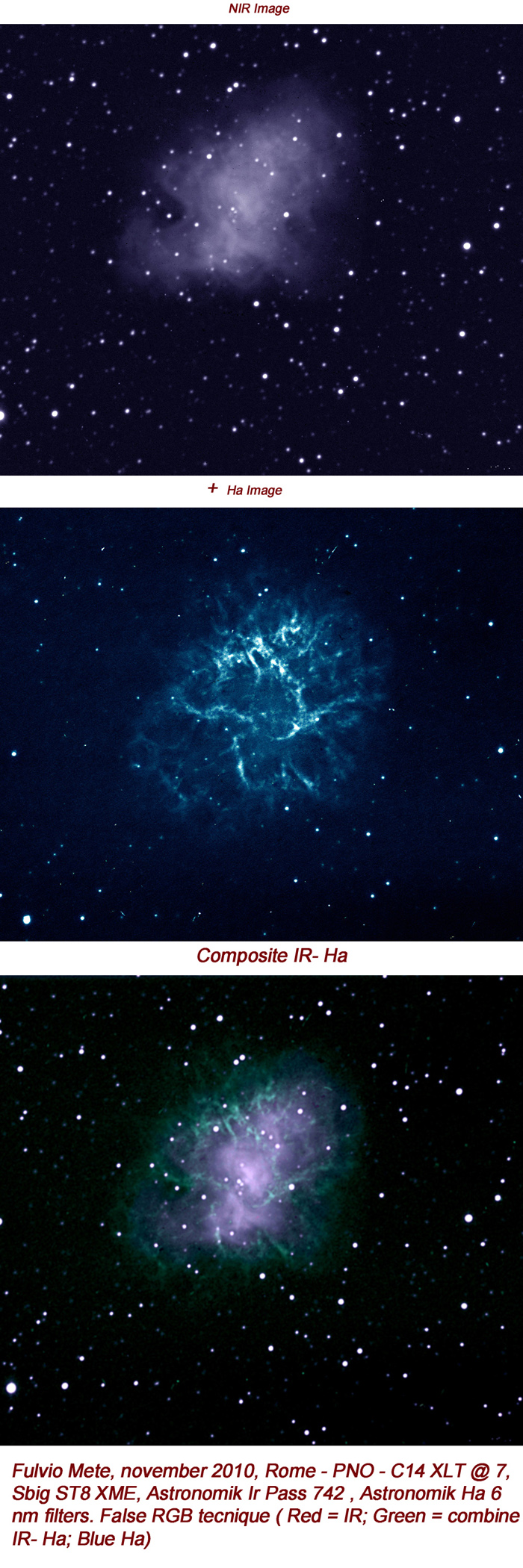
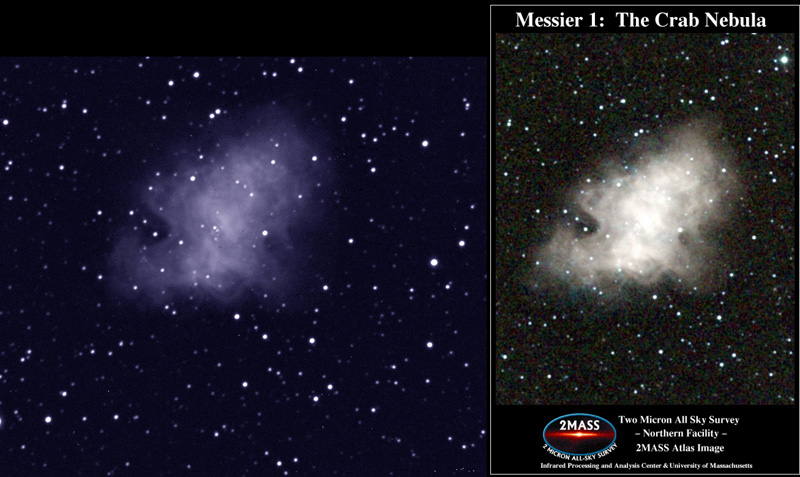
Cosa strana, come si è detto, è che la parte
centrale dell'immagine composita richiama la struttura indotta dalle
particelle ad alta energia emesse dalla pulsar situata nel cuore di
M1,struttura ripresa dal satellite X Chandra.Tale struttura appare
visibile anche nella sola immagine NIR che precede.
As said. the central
part of composite image recalls the structure caused by high energy
particles emitted by pulsar in the center of nebula,structure shot by
Xrays satellite Chandra (source NASA).
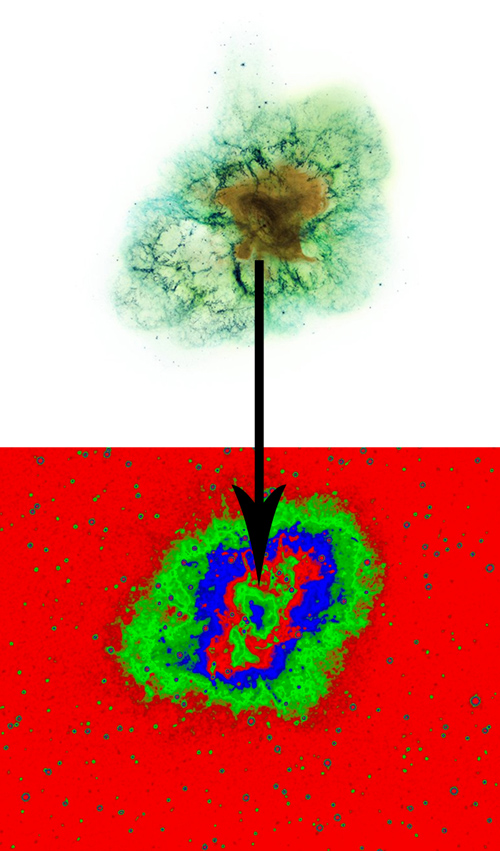
Mi sono chiesto più volte di come tale
struttura fosse visibile in IR anzichè a lunghezze d'onda minori, come
nel vicino UV, e l'unica spiegazione logica è data dalla risposta
dei filtri Astronomik Ha da 6 nm e IR planet 742 , che riportano
entrambi un picco di intensità intorno ai 370 nm.
Nella figura sottostante è riportato un
collage con la risposta quantica dei filtri IR da me usati Baader 685
(blu) , Astronomik 742 e 807(rosso) come desunta dai grafici riportati
sui siti dei produttori, paragonata a quella del sensore Kaf 1603 che
equipaggia la camera Sbig ST8.Anche se il grafico della QE del sensore
1603 termina a 400 nm, è facile vedere come, con tutta probabilità esso
intercetta anche il picco di risposta dei filtri IR Astronomik a 370 nm
per una percentuale stimabile intorno al 35-40%.
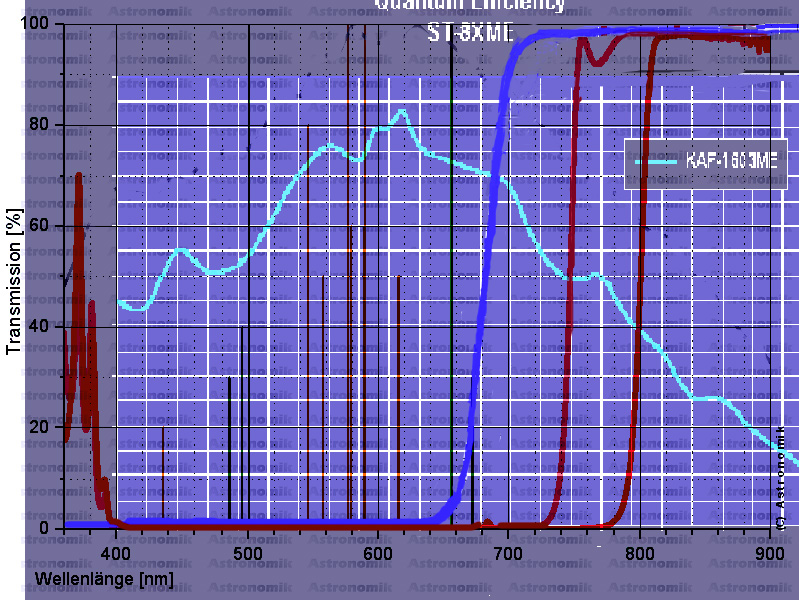
La
nebulosa M42 in Orione nel vicino infrarosso
M42 nebula in Orion
in Near IR
La nebulosa classificata nel catalogo
Messier come M42 è una nebulosa diffusa situata a sud della
cintura di Orione,la grande costellazione che domina i cieli invernali e
dista circa 1345 anni luce dalla terra.Essa è probabilmente uno degli
oggetti più osservati e fotografati del cielo, sia dagli astronomi
professionisti che dagli amatori.I colori predominanti della nebulosa
nel visibile, che costituiscono un'irresistibile attrattiva per i
neofiti dell'astronomia sono il rosso , il blu-violetto ed il verde. Il
rosso è dovuta all'intensa radiazione nel dominio dell'Idrogeno
Alfa,mentre il blu-violetto è effetto della massiccia radiazione blu ed
Uv della stelle di classe O al centro della nebulosa,ed il
verdognolo è dovuto all'Ossigeno doppiamente ionizzato.La parte centrale
della nebulosa, dove si trova un vero e proprio conglomerato di polveri
e gas è quella della cd."zona del trapezio", che prende il nome dalla
forma della struttura che ospita le caldissime stelle della zona.La zona
centrale della nebulosa è una vera e propria zona di creazione stellare,
nella quale oltre 700 stelle si trovano in stato di formazione a diversi
stadi, e nella quale nei dischi protoplanetari, molti dei quali scoperti
dall'HST, che si formano quando le nubi di gas e polveri delle regioni H
II si contraggono e collassano sotto la propria massa convertono
l'energia potenziale gravitazionale in energia termica innescando
la fusione nucleare che da vita alle stelle.La coltre di polveri e gas
oscura tuttavia nel visibile le zone di formazione stellare e le stelle
giovani al centro della nebulosa, nascondendole alla nostra vista
nell'osservazione visuale ed ai sensori CCD nell'imaging nel visibile.Nel
vicino IR, invece, la capacità di penetrazione della radiazione IR
consente di osservare in tutto il suo splendore questa nursery di
stelle, come è dimostrato dalle immagini che seguono.Anche in tale
settore quindi l'uso di filtri IR pass mette a disposizione dell'amatore
un potente mezzo d'indagine.
The Messier nebula classified as M42 is a diffuse nebula
situated south of Orion's belt, the big constellation that dominates the
winter sky and it is about 1345 light years far from earth.It is
probably one of the most observed and photographed objects in the sky,
both by professional astronomers and amateurs.The predominant colors of
the nebula in the visible, which are an irresistible attraction for
newcomers to astronomy are red, blue-violet and green. The red is due to
the intense radiation in the domain of Hydrogen Alpha, while the
blue-violet is the result of the massive blue and UV radiation of the
stars of class O at the center of the nebula, and the greenish due to
the doubly ionized Oxygen.The central part of the nebula, where there is
a real mix of dust and gas is that of so called. "trapezium area," which
takes its name from the shape of apparent structure of very hot central
star of the nebula.This is a real area of stellar creation, in which
more than 700 stars are in a state of formation at different stages, and
in which the protoplanetary disks, many of them discovered by HST, which
are formed when clouds of gas and dust of H II regions are shrinking and
collapsing under its own mass, convert the gravitational potential
energy into heat energy by triggering nuclear fusion that gives life to
stars.The blanket of dust and gas obscure, however, in the visible
wavelenghts the star formation zones and young stars in the
center of the nebula, hiding them from view both in visual observations
and CCD imaging.In the near IR, however, the penetration ability of IR
radiation let this nursery of stars to be observed in all its glory, as
it is demonstrated by the following images ,so the use of IR pass
filter provides a powerful means of investigation for serious amateur
astronomers.
Nell'immagine che segue è mostrato un confronto tra l'apparenza del
"core" della nebulosa nel visibile, in Ha e nel vicino IR tra 740 e 1000
nm, limite superiore delle ottiche e della camera usata per la raccolta
di radiazione IR.Come si può osservare, l'immagine centrale,> 742 nm,
che è quella che , anche per la maggior trasmissione ed ampiezza di
bandpass del filtro, mostra il maggior numero di stelle, un vero e
proprio tappeto di stelle giovani.Le immagini sono state ottenute con lo
strumento principale dell'Osservatorio, il Celestron 14, con focale
ridotta a f 7, ed una camera CCD Sbig ST8 XME, usando filtri Astronomik
Ha e Ir pass.
Salta subito all'occhio la drammatica differenza, quanto a
stelle visibili, tra l'immagine nel visibile e quella IR, entrambe
virate in falsi colori.
At a glance, the dramatic
difference between the visible and IR image, both in false colors:
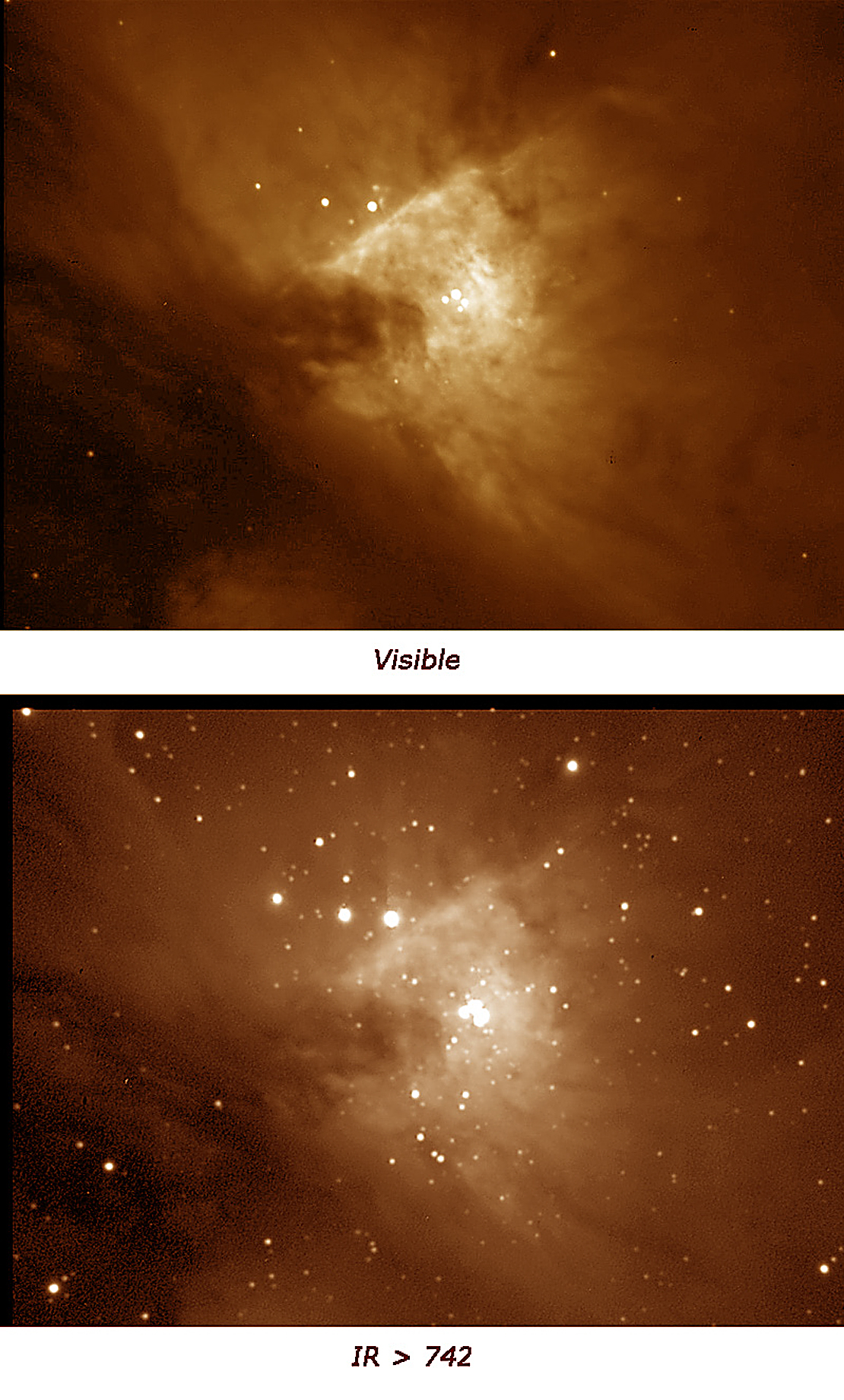
Per rendere meglio visibile la impressionante
differenza tra le stelle visibili in entrambe l'immagine in visibile è
stata sottratta da quella in IR e le stelle relative (enfatizzate in
negativo), colorate in rosso, quindi le stelle in Vis sono min rosso e
quelle in IR in nero.E ciò considerando un'immagine IR di soli 270
secondi, ovvero 4 ,5 minuti di integrazione!
To make better
evident the impressing difference between the stars in the IR and
visible images, these have been substracted from each other, and the
star present in the visible one colored in red.And this with an IR image
of only 270 secs, say 4 ,5 mins of integration!
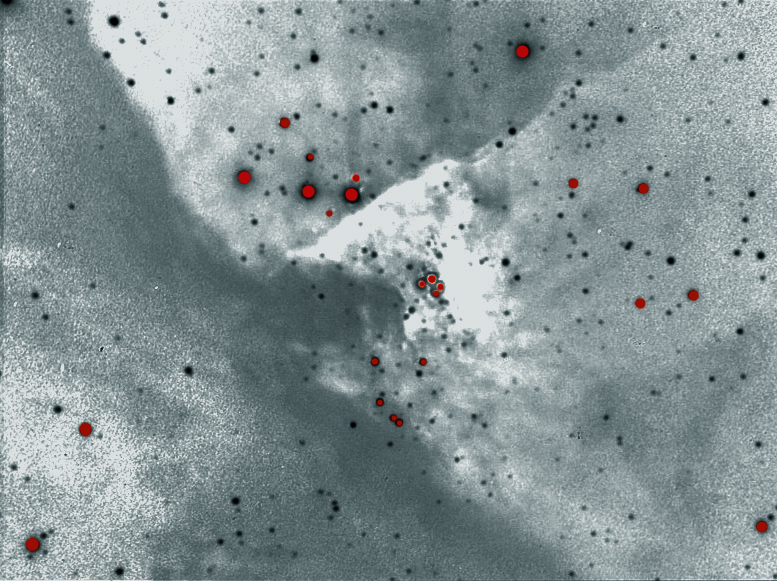
Nell'immagine che segue è invece riportata
una falsa LRGB ottenuta assegnando il colore rosso all'immagine IR> 807
nm; il verde a quella IR > 742 nm, ed il blu a quella Ha ed usando
come luminanza l'immagine IR 742 cui è stato applicato un filtro DDP.Il risultato
permette di osservare buona parte del "velo" dell'Ha (in blu)sovrapposto
alle zone di formazione stellare al centro della nebulosa.Una Nebulosa
di Orione piena di stelle!
In the following image is instead reported a false LRGB obtained by
assigning the color red to the IR> 807 nm, the green to the IR> 742 nm,
and blue to the Ha and using as luminance the IR 742 image to which a
DDP filter has been applied.The result allows to observe the great part of
the "veil
" of Ha (in blue)superimposed on the areas of star formation in the
center of the nebula.
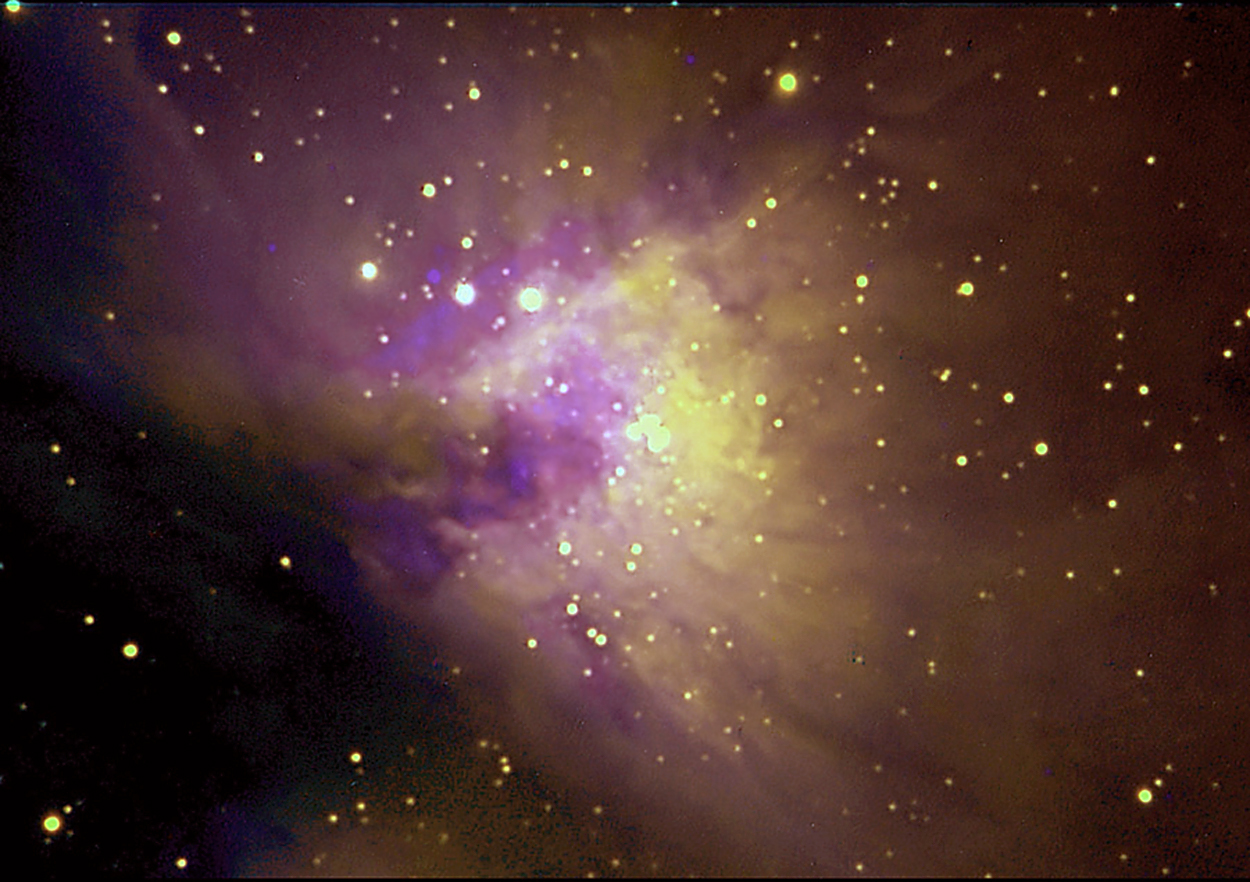
NGC 2024 - The flame
Nebula
La celebre Ngc 2024 (nebulosa fiamma),in
Orione, ripresa il 30 dicembre 2010 con un rifrattore da 80 mm di
diametro e 560 mm di focale in IR- Ha con la stessa tecnica di
falso LRGB descritta in precedenza.Il risultato è analogo, visto il
notevole numero di stelle visibili, nonostante il modesto diametro
dell'ottica.Suggestivo il blooming della stella Zeta Orionis.
The famous NGC 2024
(Flame Nebula) in Orionis, shot on December, 30 2010, with an 80 mm 560
mm FL ED refractor with the same technique of false LRGB
previously described.
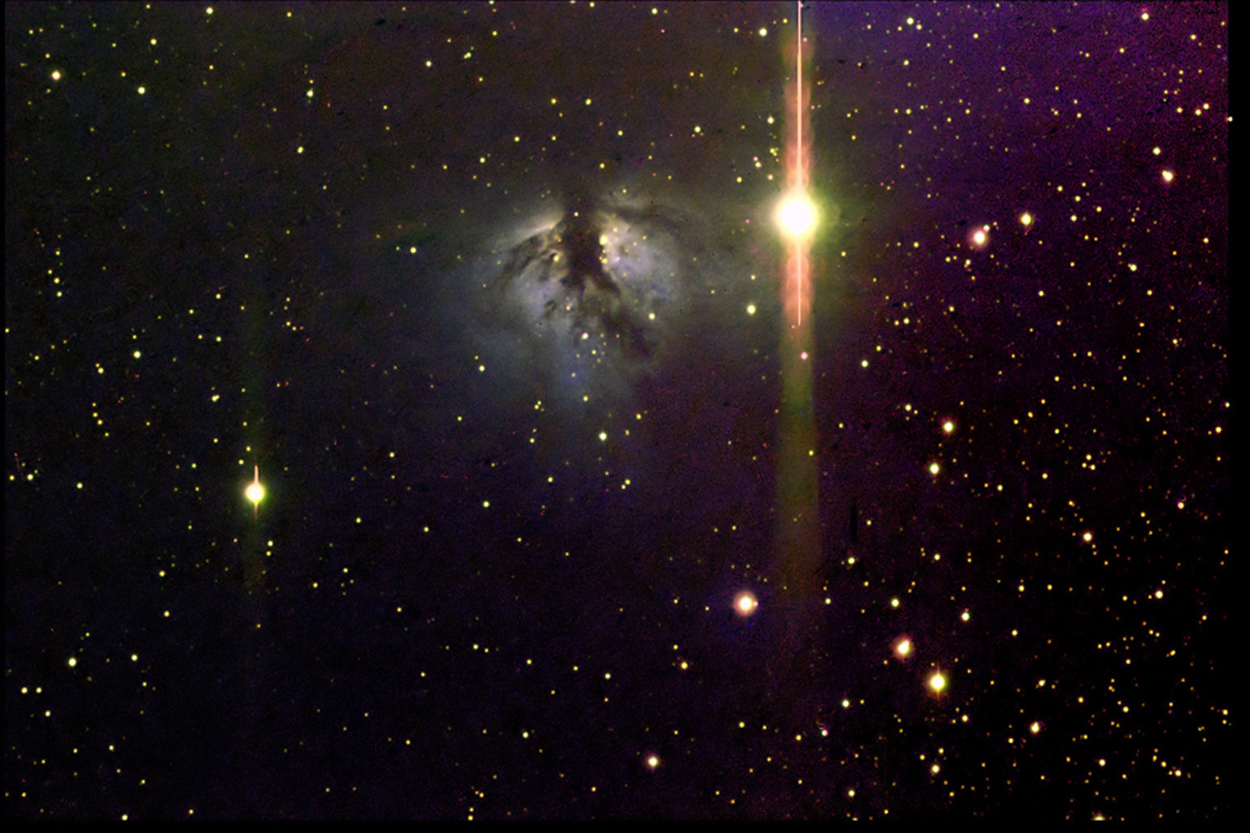
NGC 2841: Una galassia infrarossa
NGC 2841: an
infrared galaxy
Una ripresa di NGC 2841, una galassia famosa
per le sue regioni di formazione stellare nascoste dalle polveri , che
l'infrarosso aiuta a penetrare.Stacking di 4 immagini da 5 min per i
canali blu, rosso e IR,con la camera Sbig ST8 al fuoco del C14 ridotto
ad f 7.Roma, 10 marzo 2011.
A shot of Ngc 2841 ,
a galaxy well Known for its star forming regions hidden by dust, that Ir
help to penetrate.Stacking of 4, 5 mins each frames, for blue, red, IR
channels by a Sbig ST8 camera at the focus of C14 @ 7.Rome, march 10
2011.
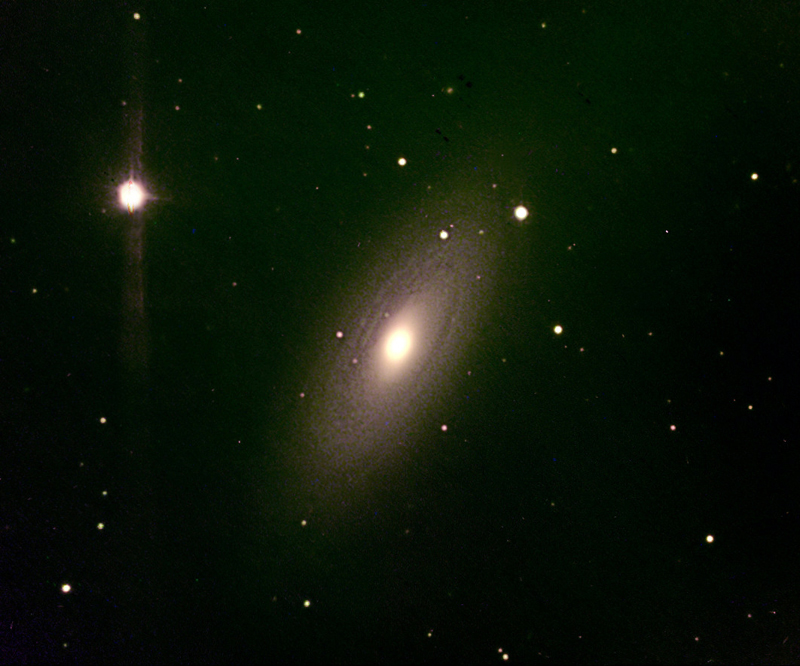
NGC 7814
NGC 7814 è una
galassia a spirale vista di taglio situata a
circa quarantanove milioni di anni luce di
distanza in Pegaso. Possiede una mag
apparente di 10.8, e una sua caratteristica
principale è la banda di polveri che la
attraversa, insieme ad un bulge cospicuo,
che la rendono simile a M104..Una sua
ulteriore caratteristica è che la banda di
polveri è sdoppiata, nel senso che essa è
osservabile anche nella sua parte
posteriore, dietro al nucleo.Tale aspetto
risulta ancora più evidente nelle immagini
del vicino IR, come la prima di quella che
seguono, ottenuta col mio C14 @f7 da Roma ,
con 2400 sec di integrazione della Sbig ST8
con un filtro IR Pass Astronomik 742., che
ha permesso altresì di penetrare il bulge di
polveri e gas del nucleo, facendo scorgere
molte piccolissime galassie di sfondo
attraverso il nucleo stesso.La seconda
immagine in luce visibile (Filtro Ir cut
astronomik), oltre ad essere comunque
peggiore per effetto del seeing, non mostra
altrettanto bene lo spazio tra le due bande
scure e le numerose stelle e galassie
visibili attraverso il bulge.
|
|
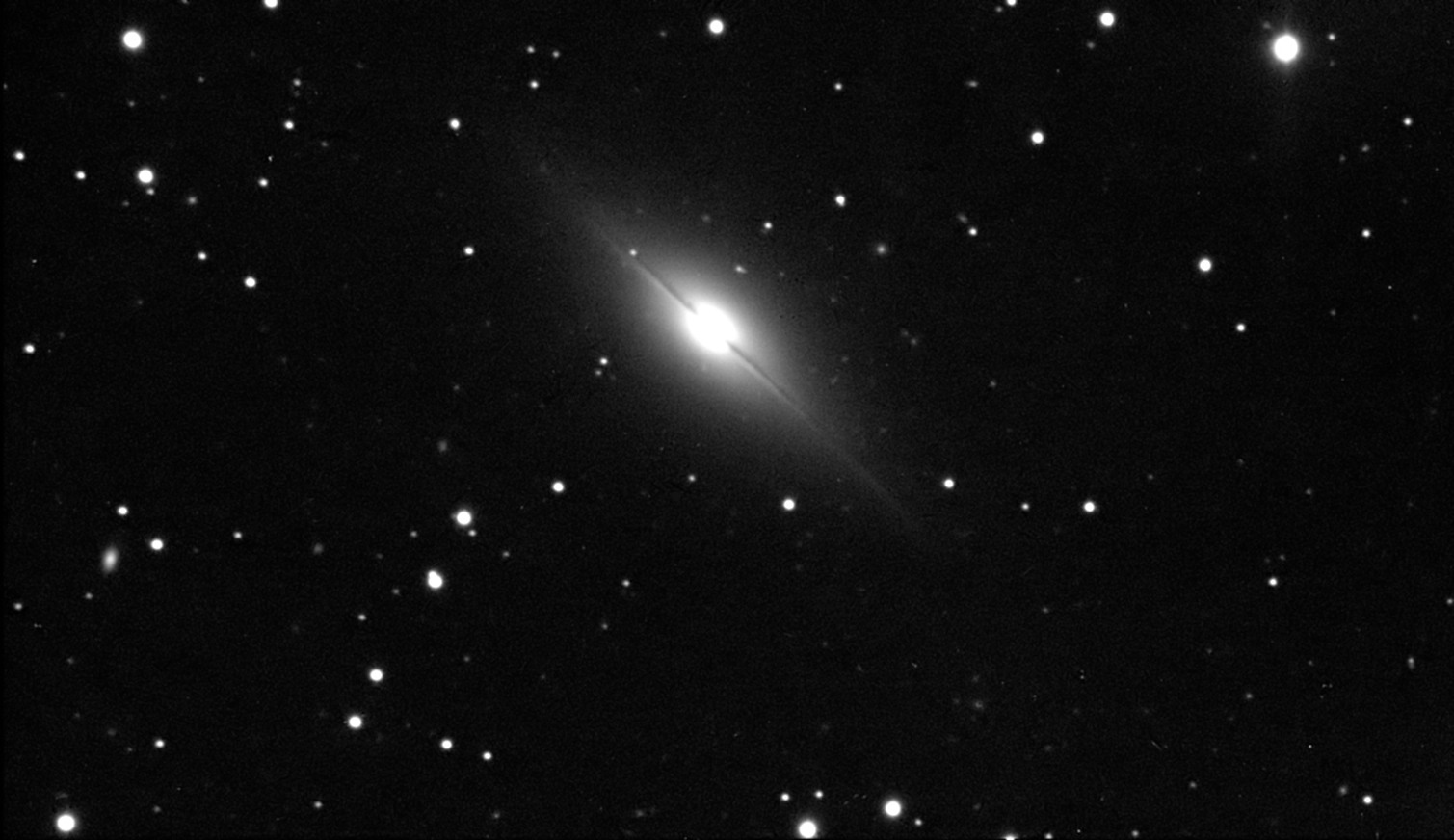
Ngc 7814 NIR > 742 nm
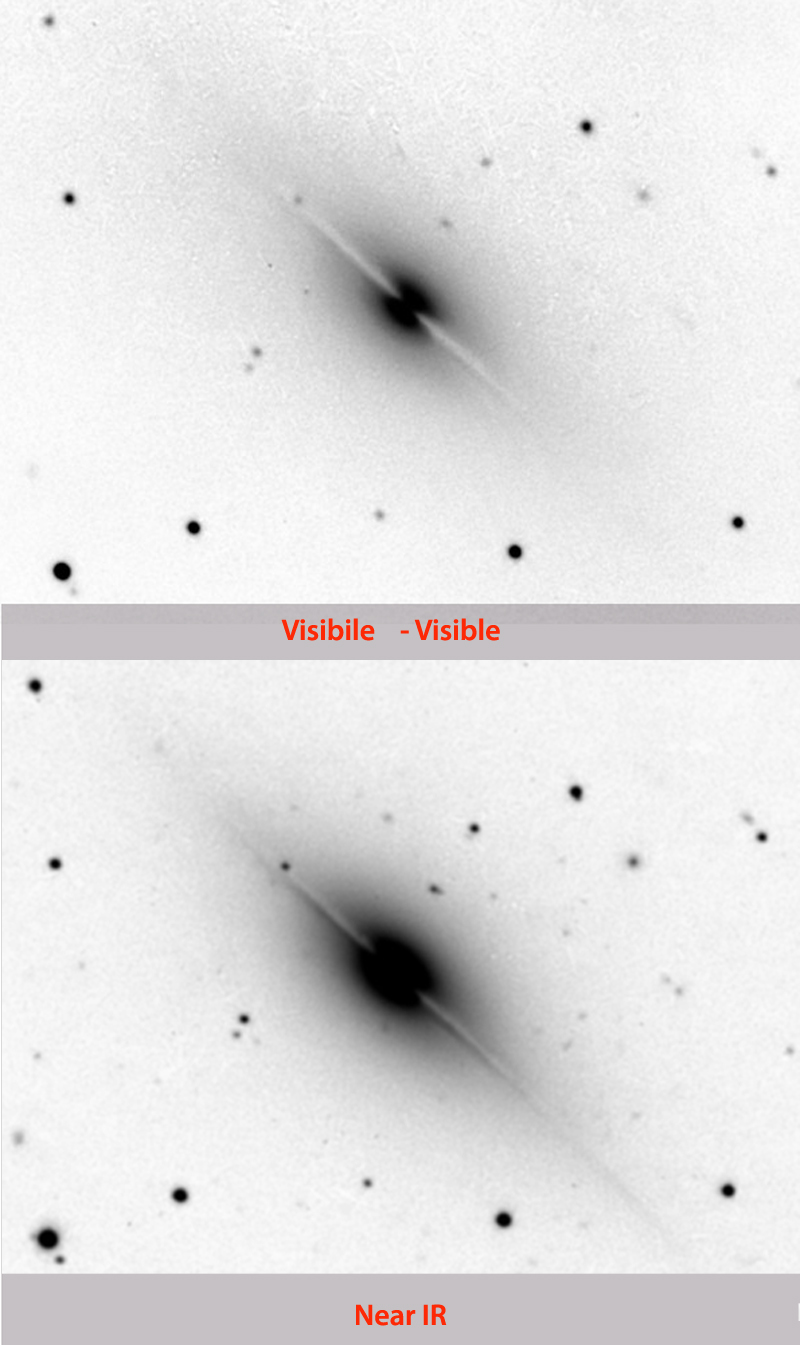
NEW!
L'infrarosso come mezzo di
controllo dell'inquinamento luminoso e del seeing sfavorevole
qui
(Italian only):
IR e IL.pdf
Le stelle perdute di M57
The lost stars of
M57
M 57, la nebulosa
ad anello della Lira, è senza dubbio uno degli oggetti più fotogenici e
fotografati del cielo estivo.Ciascun astrofotografo possiede sicuramente
immagini più o meno belle, accattivanti o interessanti della nebulosa
planetaria in questione. Pochi tuttavia sanno che le stelle visibili
nell’intricato inviluppo di gas (essenzialmente OIII e Ha) non sono
quattro, come appare nella stragrande maggioranza delle immagini
amatoriali, ma 6, in quanto due di esse sono completamente occultate
nella parte di emissione Ha sul bordo nord dell’ellissoide formato dalla
nebulosa.
Il 6 giugno 2013,
più per curiosità che per altro, o effettuato una ripresa CCD
dell’oggetto in questione dal mio osservatorio di Ponte di Nona a Roma,
nonostante che il cielo fosse a tratti velato.
Ho effettuato e
sommato tra loro:
1- due riprese in
visibile (per la precisione una in visibile con un filtro Baader
Neodymium ed una in Ha con un Astronomik da 6 nm) per un totale di 1560
sec di integrazione
2- due riprese in
IR:una con un filtro Astronomik >742nm ed uno con un filtro >807
nm per un totale di 2400 sec di integrazione.
Nell’immagine in
IR (potenza della capacità di penetrazione della banda IR!) le due
stelline, di magnitudine 15.6 e 16.2,situate nella parte nord della
shell appaiono nettamente visibili, mentre non lo erano nell’immagine
precedente.
La scomparsa della
Nebulosa Testa di Cavallo e la strana storia di IC 434.
Fare imaging deep
sky dai centri cittadini
The disappearance of
Horsehead Nebula and the strange story of IC 434
How to shot images
of deep sky objects from cities
La Nebulosa B33 in IC 434 è parte di un complesso di gas e polveri, sagomato come
la testa di un cavallo,
da cui il nome. È una delle nebulose maggiormente
riconoscibili e note del cielo, anche se è
difficile
poterla osservare visualmente: la sua forma caratteristica si può
individuare solo attraverso le fotografie della zona. La prima foto
della nebulosa , presa presso l'Harvard
College
Observatory.risale
al 1888.Da
allora sono state migliaia le foto della nebulosa che hanno riempito
giornali e siti web.
Essa è talvolta confusa con IC
434, che è in realtà la nebulosa
a emissione alle sue
spalle, di colore rosso, originato prevalentemente da
idrogeno ionizzato
(Ha).
Tuttavia pochi amatori hanno fatto
caso ad una circostanza particolare, che la B 33 praticamente scompare
quasi completamente se osservata in luce IR, come si può notare
dalle
immagini seguenti.
Due riprese, una con un filtro Ha da 6 nm
Astronomik, l'altra con un IR pass 42, sempre Astronomik: il cambiamento
è drammatico: la nebulosa semplicemente scompare a distanza di soli
100-150 nm in lunghezza d'onda!Naturalmente questa è stata solo una
prova fatta al volo (solo 2 frames da 10 min l'una) col mio TMB 115/800
e la Sbig ST8 XME, dal centro di Roma
,immagini virate in falsi colori.
The Nebula B33 is part of a complex of
gas and dust, shaped like the head of a horse, from which the name. It
is one of the most recognizable and known nebulae in the sky, even if
itit can be difficult to observe visually: its
shape
can be detected only through photographs of the area. The first photo of
the nebula was taken from Harvard CollegeObservatory.in 1888.
Since then have been thousands photos of the nebula that filled
newspapers
and websites.
It is
sometimes confused with IC 434, which is actually the emission nebula
behind it, red, mainly originates from ionized hydrogen (Ha).
However few
amateurs have made the case to a particular circumstance, that the B 33
virtually disappears almost completely when viewed in infrared light, as
you can see from the following images.
Two
shots, one with a Ha 6 nm Astronomik filter , the other with an IR pass
742 filter, always Astronomik: change is dramatic: the nebula simply
disappears after only100-150 nm in wavelength! Of course this was only a
test
done on
the fly (only 2 frames of 10 min each) with my TMB 115/800 and SBIG ST8
XME, from the center of Rome ; images in false colors.
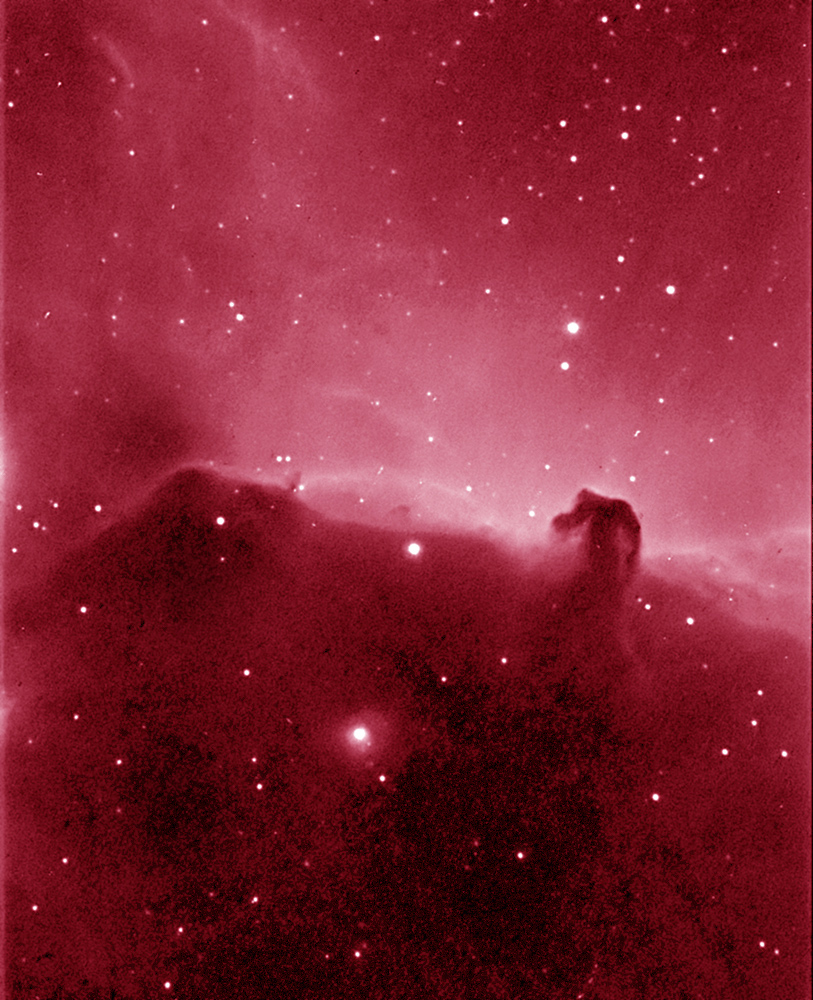
Immagine col filtro Ha da 6 nm
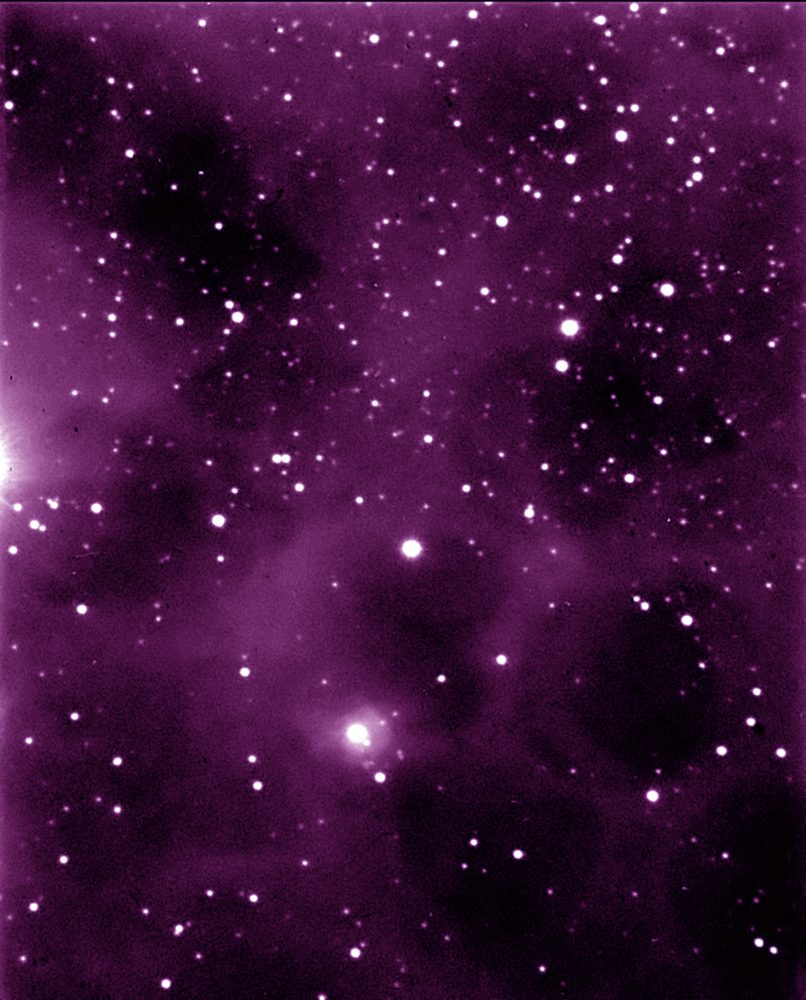
Immagine con filtro IR pass 742
Astronomik
Ma la
Horsehead Nebula in IC 434 è uno degli oggetti nebulari più suggestivi e
fotografati del cielo.In realtà si tratta di una nebulosa ad emissione
cui è sovrapposto un insieme di gas e polveri a forma di testa di
cavallo, da cui il celebre nome
Si
tratta di una regione
H II che
si estende a sud di Alnitak, sul bordo sudoccidentale della grande nube
Orion B; presenta una forma molto allungata in senso nord-sud e riceve
il vento ionizzante direttamente dalla stella σ
Orionis,
un brillante membro della grande associazione Orion OB1. La
nebulosa raggiunge i 70' di lunghezza e si mostra con facilità nelle
foto a lunga posa o nelle riprese CCD,
sebbene il suo spessore sia di pochi primi d'arco.I
filtri H alfa mostrano molto bene sia la nebulosa ad emisione che la
“testa di cavallo”.E’ un
oggetto piuttosto elusivo, che è preferibile riprendere da cieli puliti
e lontano dalla città.
Al di là di quanto detto prima ,lo scopo di questo
articolo è di fornire un’ulteriore dimostrazione di come questo e
moltissimi altri oggetti particolarmente tenui possano essere ripresi
con CCD dai centri cittadini. e, ancor di più, nelle peggiori condizioni
possibili, ovvero con luna piena e cielo velato: sembra una mission
impossibile, ma non lo è.
Tutti
coloro che credono di dover subire IL e condizioni osservative negative
senza poter effettuare imaging di oggetti celesti possono constatare
come ciò sia vero solo in parte, e che anche dalle grandi città come
Roma sia possibile fare imaging di molti oggetti deboli del cielo
profondo.
La prima delle immagini che seguono è
stata effettuata, in condizioni di normale IL (lampade
al sodio ad alta pressione, cielo lattiginoso) da Roma, con
un filtro Ha da 6 nm, e 2 integrazioni da
1200 sec ciascuna con una camera SBIG ST8 al fuoco del mio rifrattore
apo TMB 115/800.
La seconda è , , stata
invece ripresa con un
filtro Astronomik IR Pass > 742
nm con cielo parzialmente velato dalla forte
umidità e la luna quasi piena a soli 67 ° dal target, come si
vede dallo schema che segue.Senza il filtro l’immagine si sarebbe
saturata dopo alcuni minuti per il cielo perfettamente illuminato; con
questo è stato invece possibile sommare 4 integrazioni da 1200 sec per 1
h e 20 min complessivi.
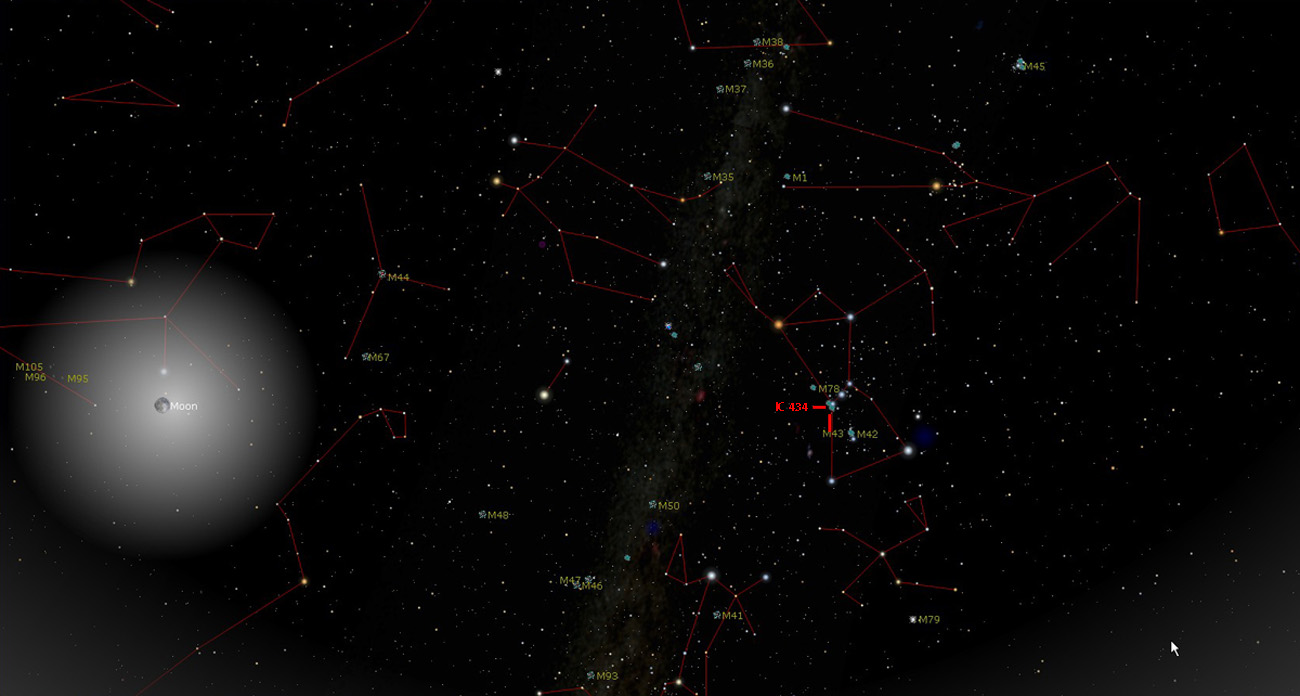
La terza è formata dalle due immagini
che precedono compositate in un'unica immagine Ha-NIR che mostra sia la
nebulosa sia, grazie alla capacità di penetrazione dell’IR le delicate
strutture della testa di cavallo in modo non dissimile da una ripresa da
cieli montani, oltre ad una notevole quantità di stelle normalmente non
visibili perché coperte da polveri e gas..
La quarta, infine, è un tentativo di
ottenere un’immagine a colori RGB assegnando al frame IR il colore
rosso, alla somma dei due frames (IR e Ha) il verde, ed all’Ha il blu.
The Horsehead
Nebula in IC 434, is one of the most attractive and interesting objects
in the sky.In the fact it is an emission nebula to which is superimposed
a complex of gas and dust in the shape of a horse head, from which the
famous name.It’s rather elusive, and preferably to shot from clean
skies and away from the city.
The purpose of this
article is yet to demonstrate how this and many other objects can be
picked up by a CCD from city centers of large cities. And, even more,
in the worst possible conditions, ie with full moon and hazy sky: it
looks like a mission impossible, but it is not.
This post is therefore
aimed at all those who believe they must undergo IL and observing
conditions without being able to make imaging of celestial objects from
the cities.
The first image of the
post has been carried out, in conditions of normal IL (high-pressure
sodium lamps, milky sky) from Rome, with a Halpha 6 nm filter, and 2
integrations of 1200 secs each with a SBIG ST8 at the focus of my
115/800 TMB LZO apo refractor.
The second image ,
instead, was shot with a Astronomik IR Pass> 742 nm with sky partially
veiled by the high humidity and the almost full moon just 67 degrees
from target, as you can see from the scheme above situated.Without the
filter the image would have been saturated after a few minutes for the
sky perfectly enlightened; but with this was possible to stack 4
integrations of 1200 secs each for 1 hour and 20 minutes total.
The third is formed by
the two preceding images into one Ha-NIR image showing both the nebula
and, due to the penetration capacity of the IR, the delicate structures
of the horse's head in a manner not unlike a shot from mountain skies
,and, in addition, a significant amount of stars normally not visible
because it is covered by dust and gas ..
The fourth, finally, is
an attempt to obtain a color RGB image assigning to the frame IR the
red, to the sum of the two frames (IR and Ha) the green, and blue to HA.


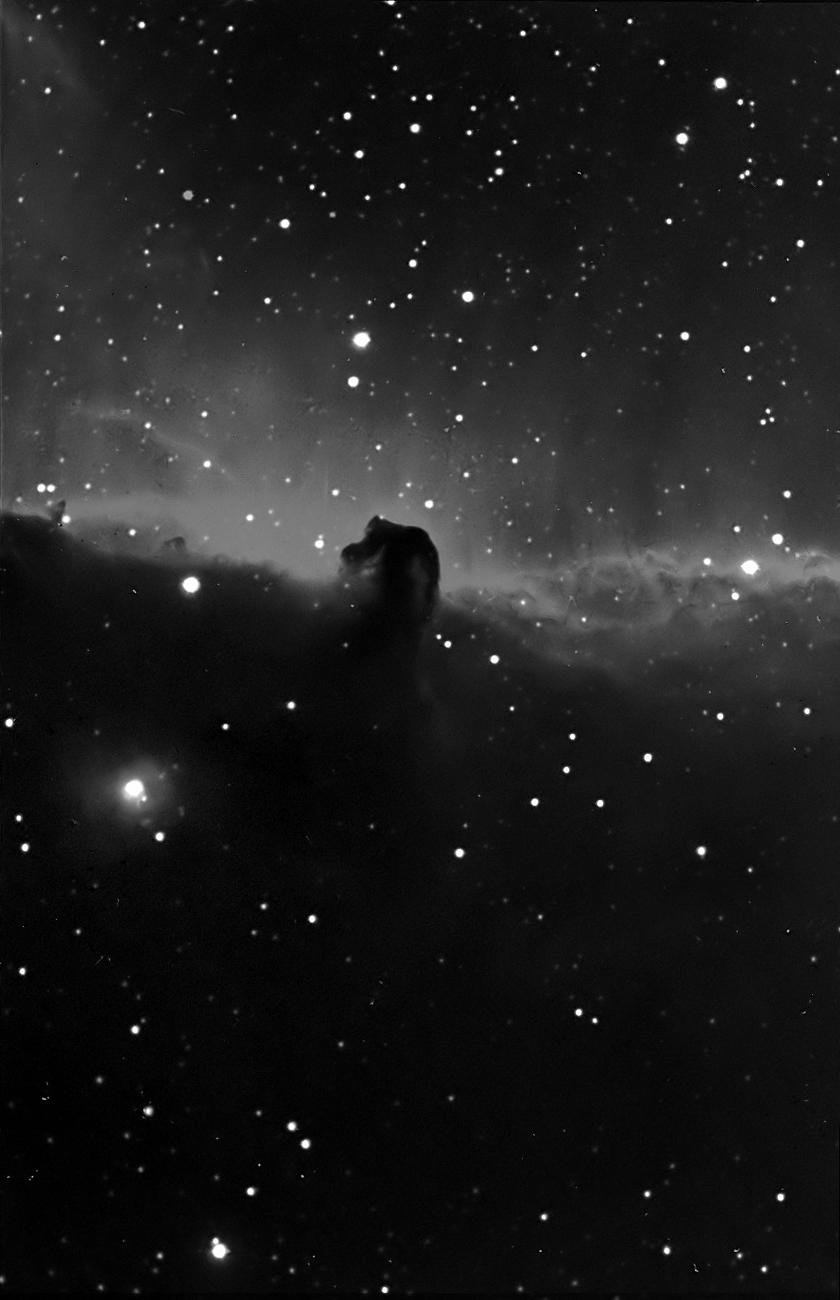
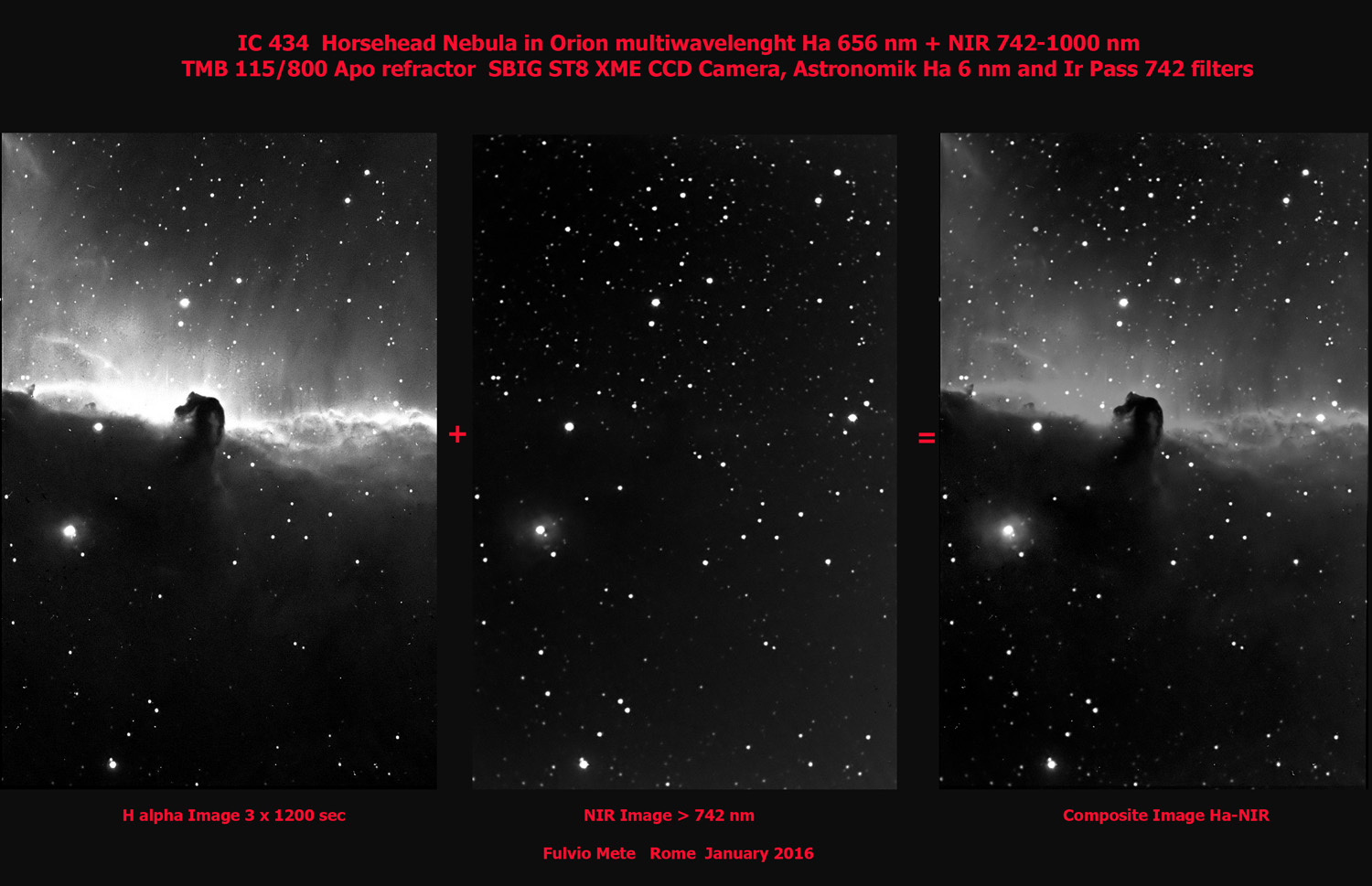
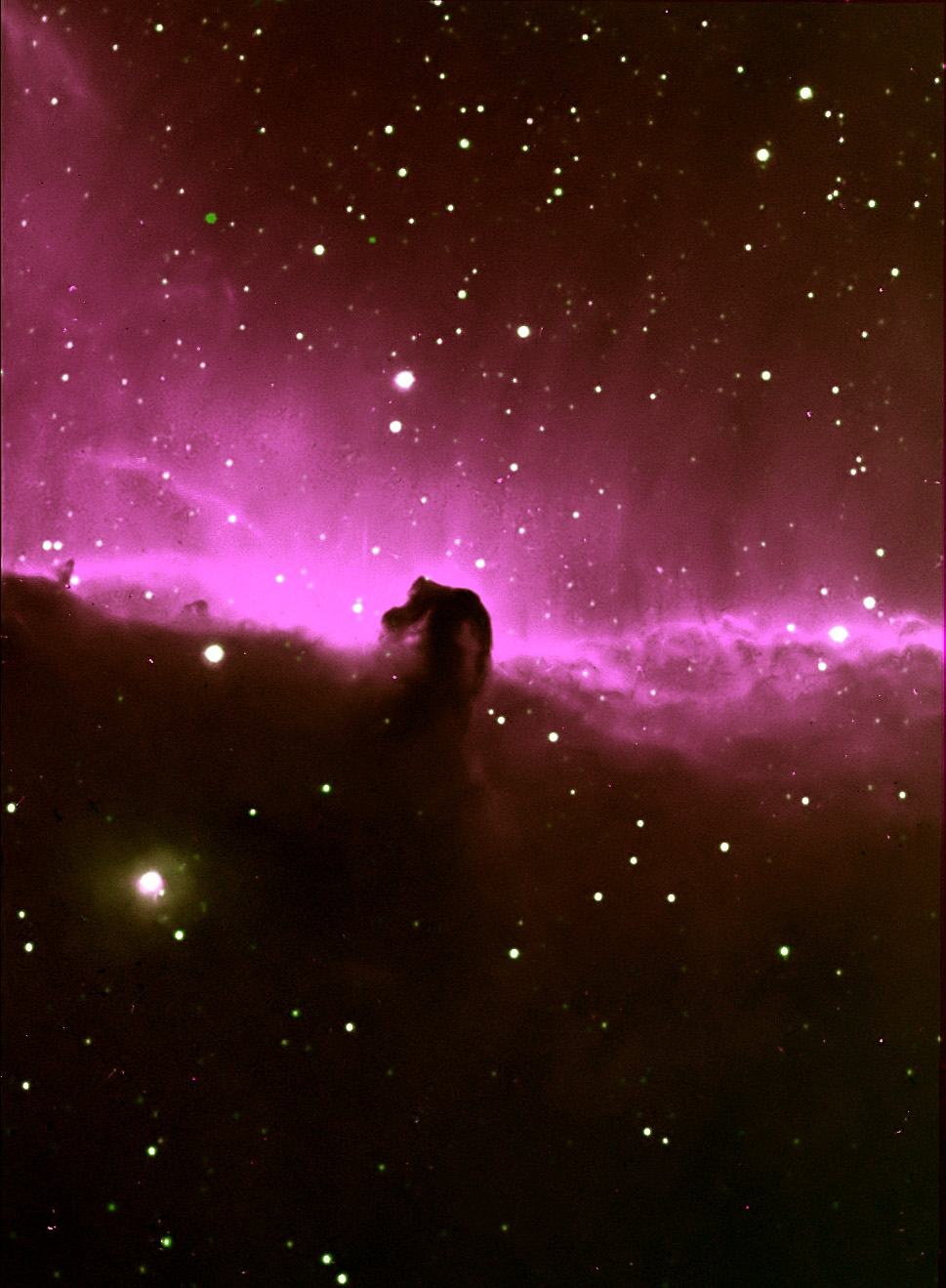
L'uso dell'IR vicino nella
fotografia solare
Use of NIR in sun
astrophotography
Usare la radiazione infrarossa sul sole,
ovvero sulla più grande fonte di radiazione termica potrebbe sembrare
un'assurdità, ma non lo è, per un semplicissimo motivo: i filtri IR pass
funzionano in pratica come filtri a banda medio-stretta , data la scarsa
sensibilità dei sensori CCD all'IR, e contemporaneamente stabilizzano il
seeing diurno che, come si sa, è infinitamente peggio di quello
notturno.Di seguito due esempi di imaging CCD in IR del sole.
Using infrared
on the sun, or the biggest source of thermal radiation might seem absurd,
but it is not, for a simple reason: the IR pass filters work in practice
as narrow-band filters due to low sensitivity CCD Sensor IR, and at the
same time stabilize the daytime seeing that, as you know, is infinitely
worse than in the night.Hereunder two examples of Sun Imaging in IR
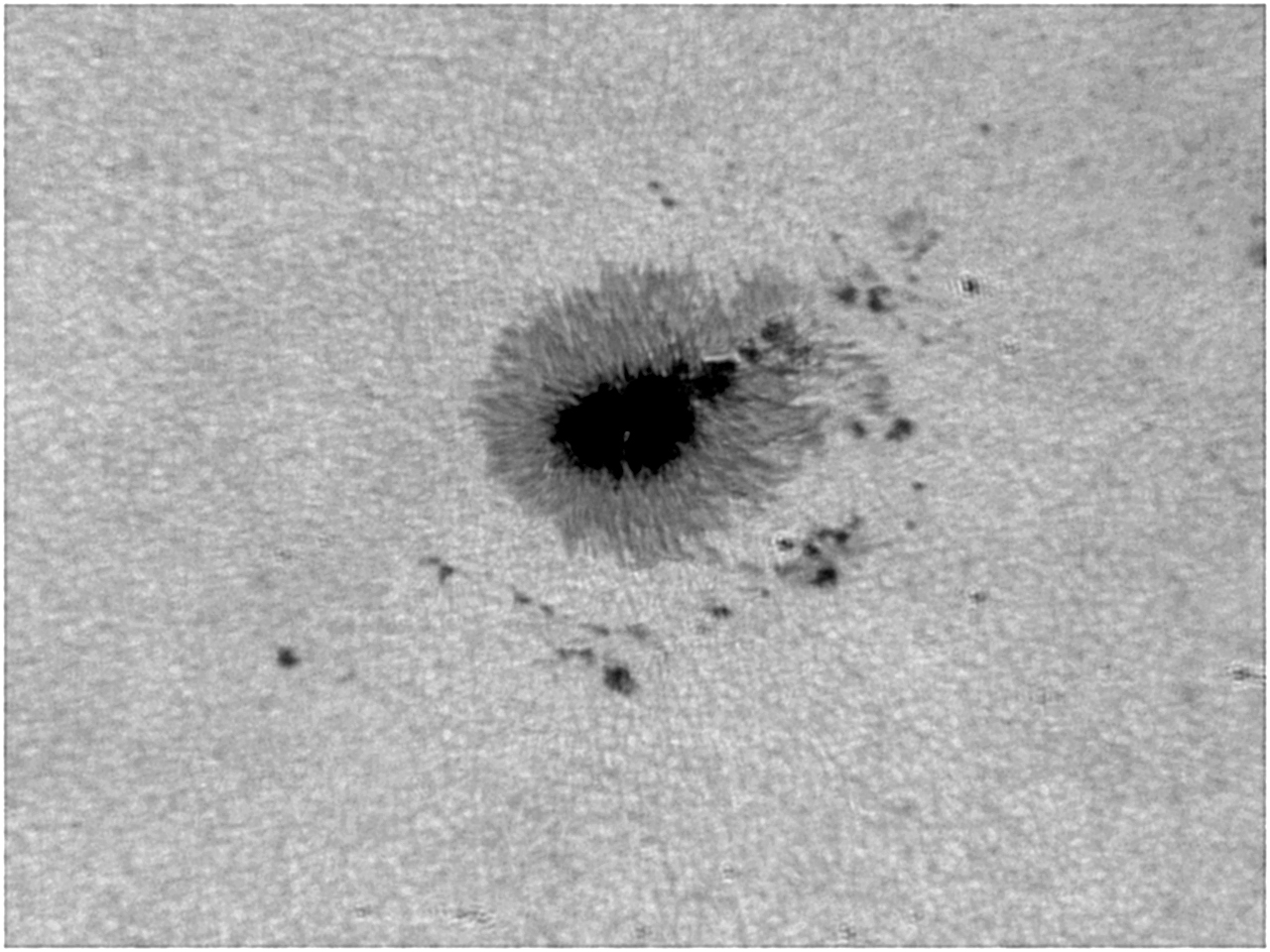
Immagine dell'AR 1877 ripresa il 23 ottobre
2013 con un Intes 180 f 10 con filtro solare Astrosolar 3.8, barlow 2X e
filtro Ir pass Astronomik 742-Camera DMK 41 AS
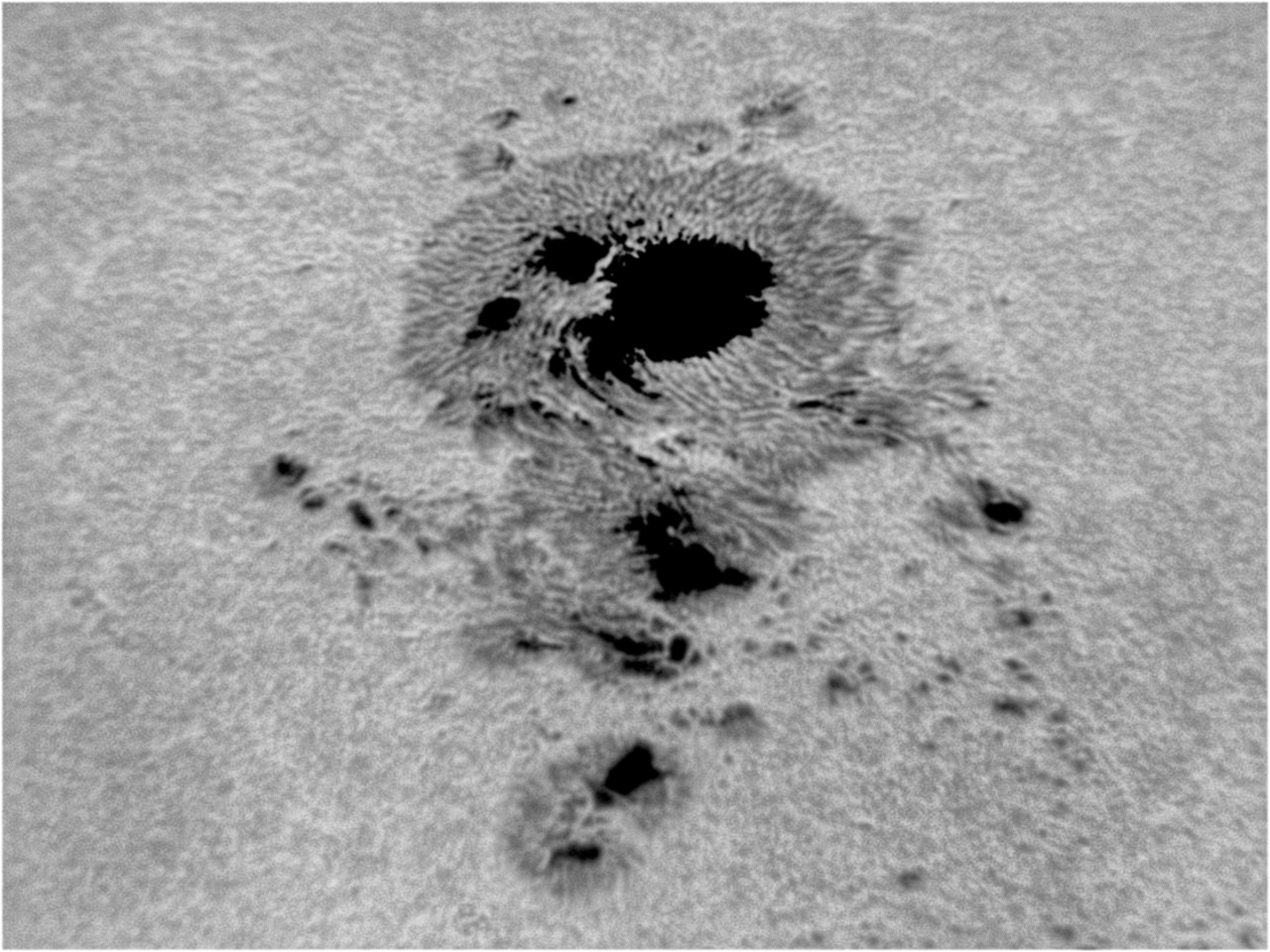
Immagine dell'AR 2192 ripresa il 20
ottobre 2014 con un TMB 115 f 7 con prisma di Herschel, barlow 5X
e filtro Ir pass Baader 685- Camera DMK 41 AS
Home


